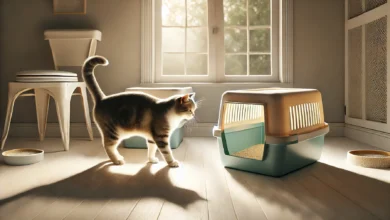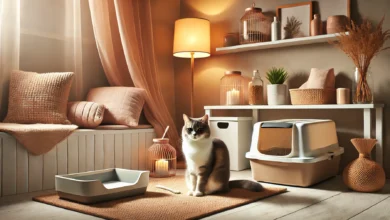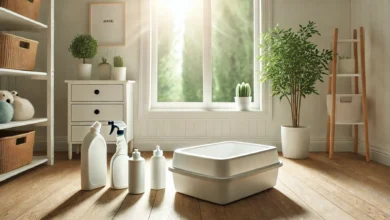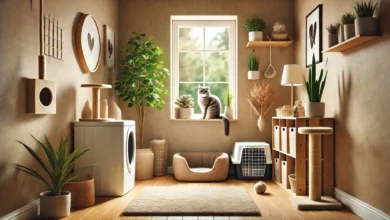How to Keep Litter Box Areas Tidy and Hygienic for Cats
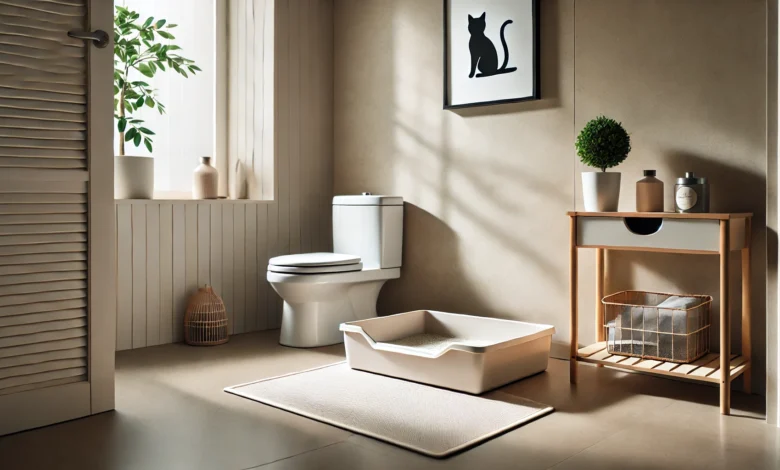
Keeping the litter box area clean and hygienic is important, not just for the cleanliness of your home but also for your cat’s health and well-being.
A clean litter box avoids unwanted odors, limits the spread of bacteria, and makes your cat return to it more often.
Cats are clean animals by nature, and providing them with a fresh, clean space to do their business can help circumvent behavioral issues such as ceasing to use the litter box entirely.
This article covers the best practices for maintaining a clean litter box environment, from selecting the right litter box for cleanliness and ease of use to other valuable tips.
Table of Contents
Selecting the Correct Litter Box for Cleanliness
Different types of litter are important, but the type of litter box really plays a critical role in keeping the area around it clean and neat.
A well-designed litter box keeps litter inside when a cat is digging, reduces mess, and even makes the cleaning process easier.
With so many available on the market, how will you go about selecting the right one for both your cat and your home?
Let’s review the various ways to determine the correct litter box for you and your feline companion.
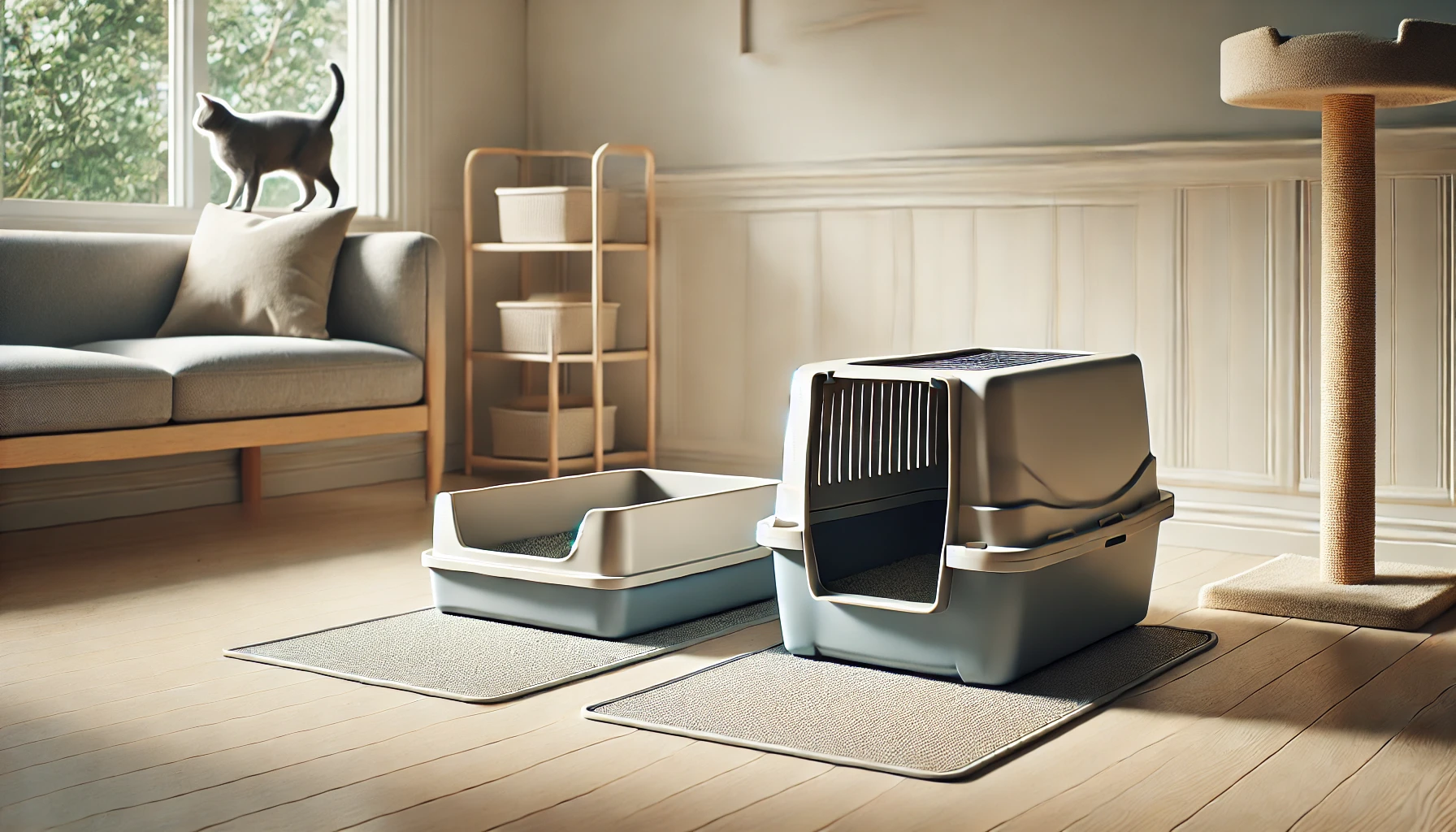
Litter Box Size and Type
Size is perhaps the most critical factor when choosing a litter box.
If the box is too small, it could make your cat uncomfortable, potentially leading to elimination outside the box.
You should aim to buy a box that is at least one and a half times the length of your cat from nose to tail.
This provides enough space for them to turn around and cover their droppings easily.
The type of litter box also matters: open boxes are easy to clean and allow good air circulation, but they may not contain odor as effectively as covered boxes.
Covered boxes provide more privacy for your cat and help trap odors inside, but they can make scooping and cleaning more challenging.
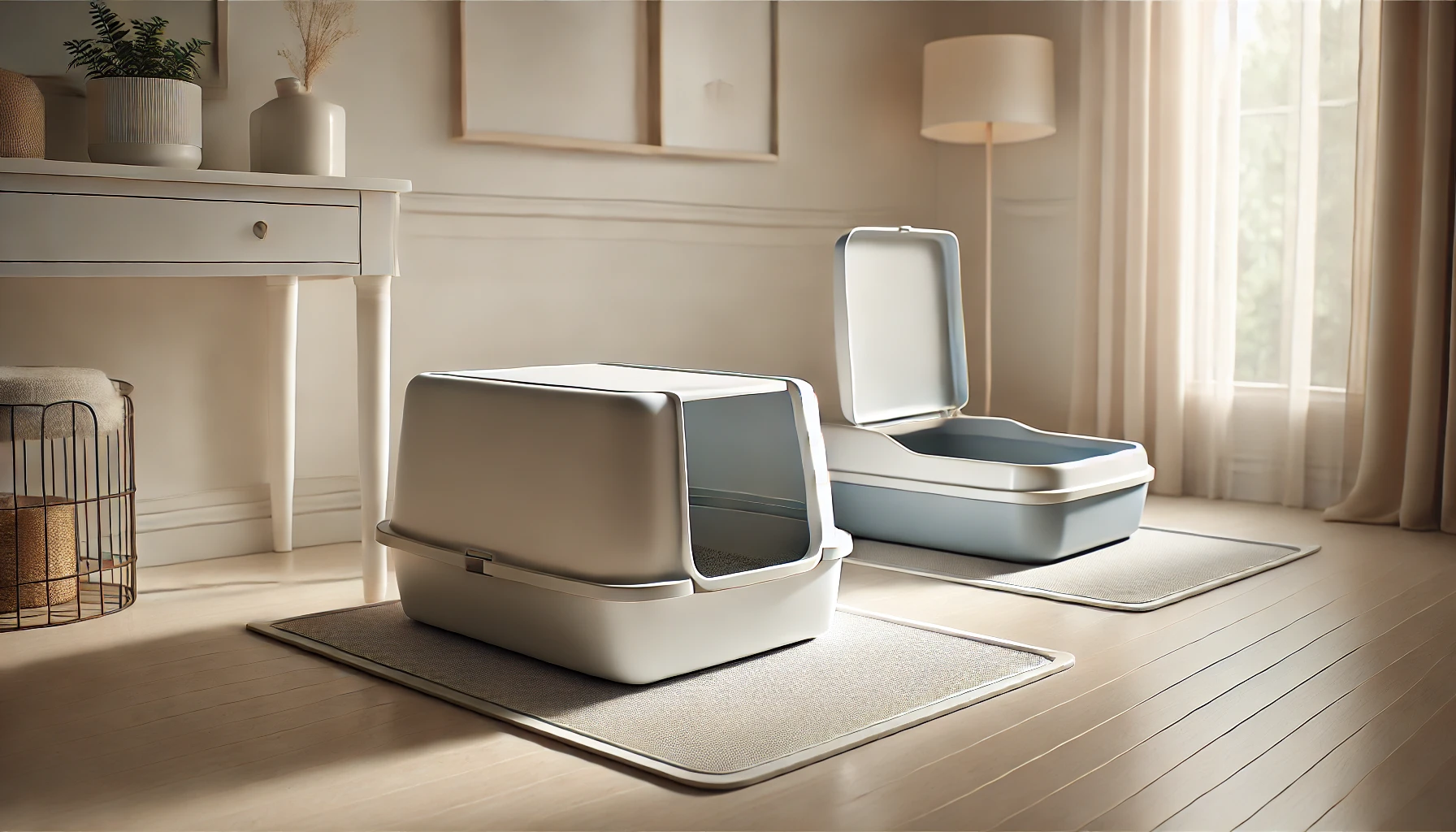
Litter Box: Covered or Uncovered
One of the major decisions you will make is whether to choose a covered or an open litter box.
The advantage of a covered box is that it contains odors and prevents litter from being kicked out as much, making it very suitable for households with more than one cat or in areas where you want to control odors.
However, some cats may find a covered box claustrophobic or uncomfortable.
Open boxes, though more exposed, are often preferred by cats that like to see their surroundings.
It’s important to gauge your cat’s preferences, as some felines will avoid covered boxes, whereas others may appreciate the privacy they provide.
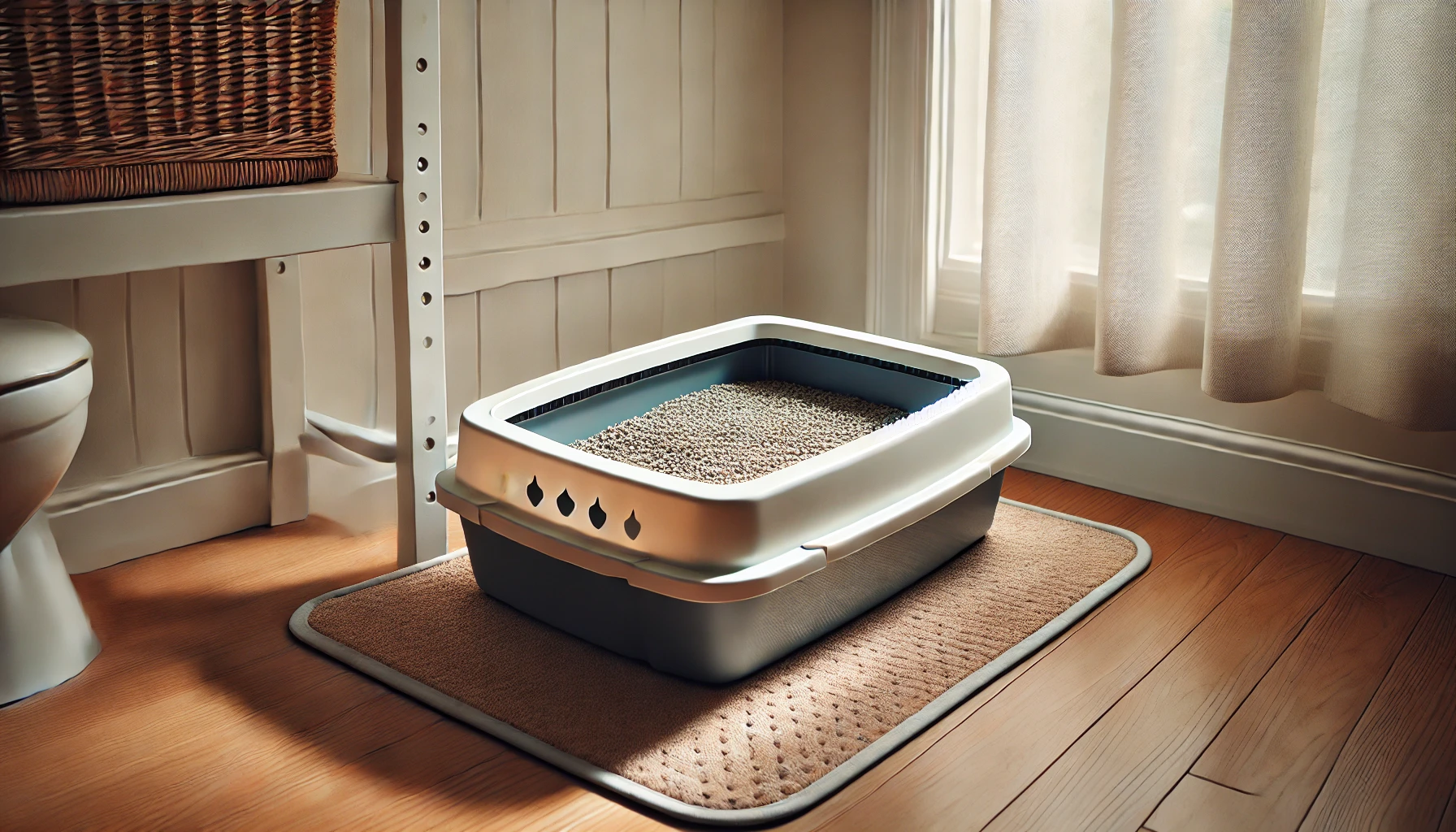
The Role of Litter Box Liners
Litter box liners are supposed to make cleaning easier by enabling you to remove all the litter in one go, but they are not universally liked by cats.
Some cats may scratch right through the liner, rendering it less effective.
Though liners can save time and reduce mess, they often allow litter to get caught underneath, which creates additional cleaning work.
If you choose to use liners, opt for durable ones that are resistant to tears, and ensure you replace them regularly.
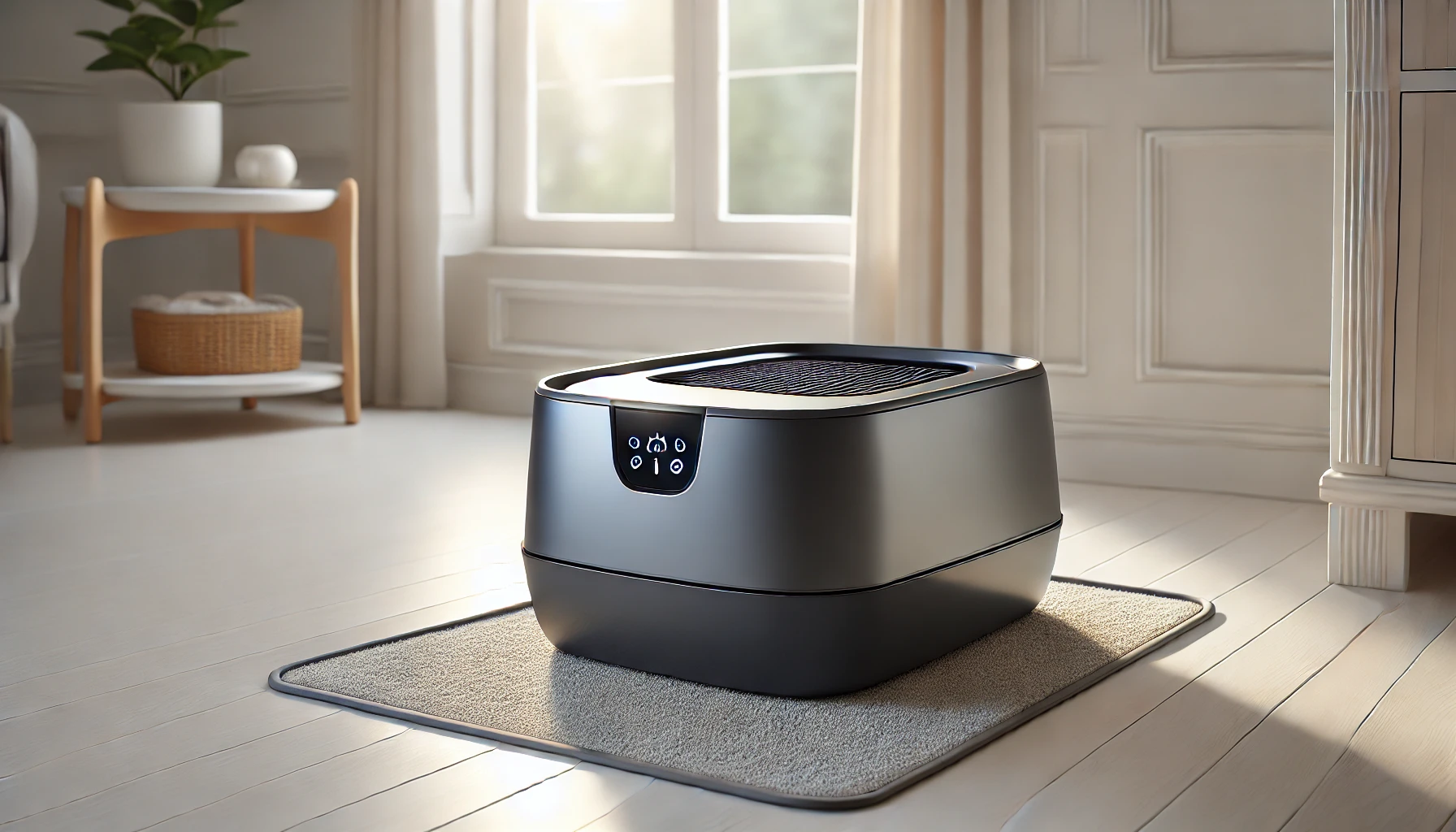
Self-Cleaning Litter Boxes: Are They Worth It?
Self-cleaning litter boxes have gained popularity recently due to their convenience, but are they the right choice for you?
These automated boxes clean themselves after each use, saving time and effort in maintaining general cleanliness.
While they can be great for busy pet owners, they tend to be more expensive, and some cats may need time to adjust to them.
Additionally, these boxes still require regular maintenance, such as emptying waste trays and refilling litter.
Consider the pros and cons before deciding if a self-cleaning litter box is right for you, and assess whether your cat can adapt to it.
Choosing the right litter box is key to reducing mess and maintaining cleanliness. Opt for a box that suits your cat’s size and comfort preferences while considering if a covered or uncovered design works best.

Best Types of Cat Litter for Easy Maintenance
With so many types of cat litter available, it’s easy to get overwhelmed.
Each offers its own set of advantages—from odor control to ease of cleaning, the best litter will go a long way in keeping your cat’s litter box area clean and hygienic.
This will save you a lot of cleaning time while also providing a happy, comfortable space for your cat.
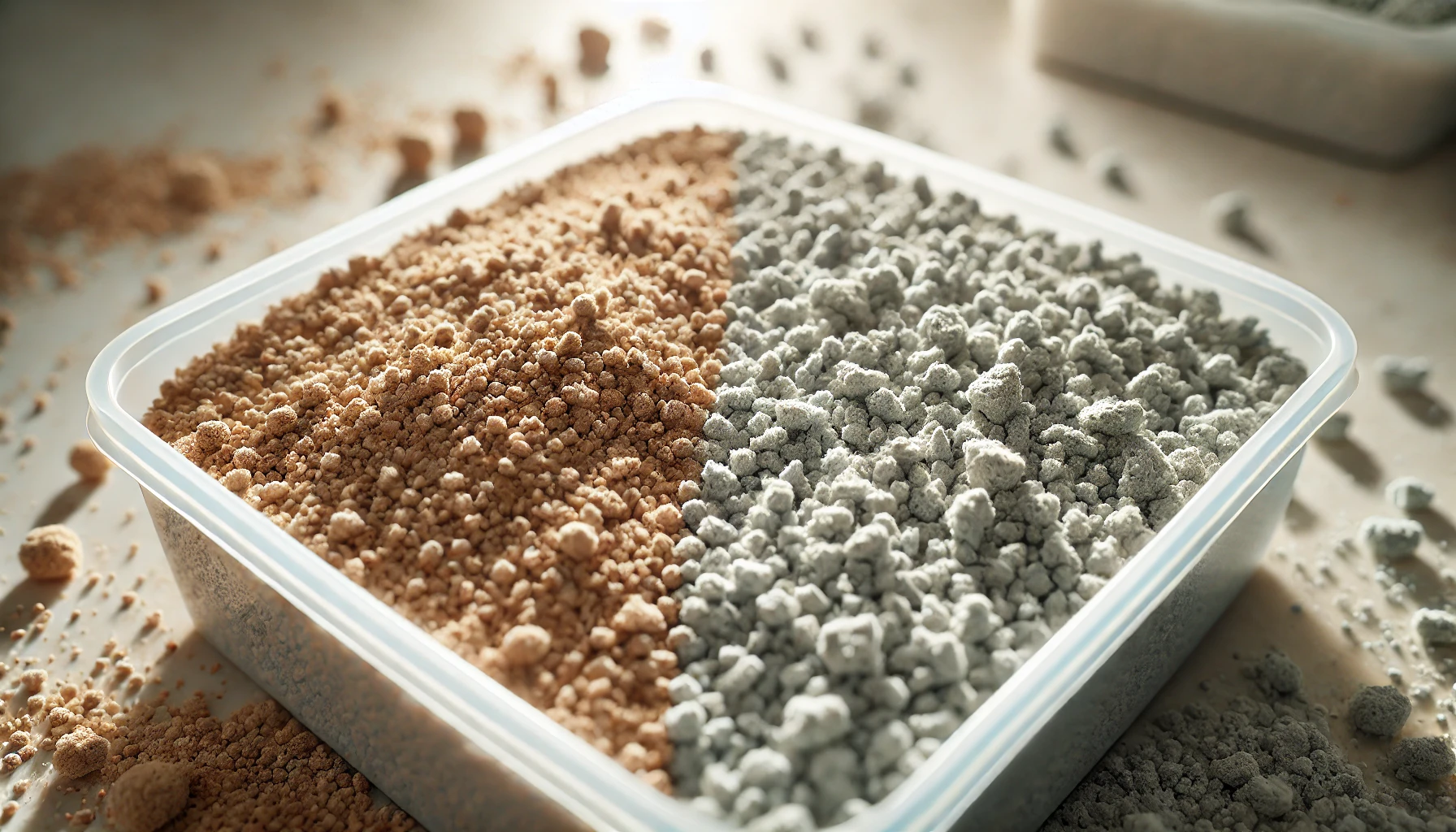
Clumping vs Non-Clumping Litter
First and foremost, you need to decide between clumping and non-clumping litter.
Clumping litter forms solid clumps when it comes into contact with moisture, making waste removal easy without the need to change all the litter.
Generally, this type of litter is more convenient for day-to-day cleaning and controls odors very well.
Non-clumping litter, on the other hand, absorbs moisture without forming clumps.
The lack of clumping with these may necessitate more frequent litter changes.
While non-clumping litter can still manage odors, it is typically more budget-friendly and may be better suited for households with multiple cats, as it tends to be less expensive.
- Clumping Litter: Solid clumps form for easy scooping and good odor control.
- Non-Clumping Litter: Absorbs moisture but requires more frequent changes and is often less expensive.
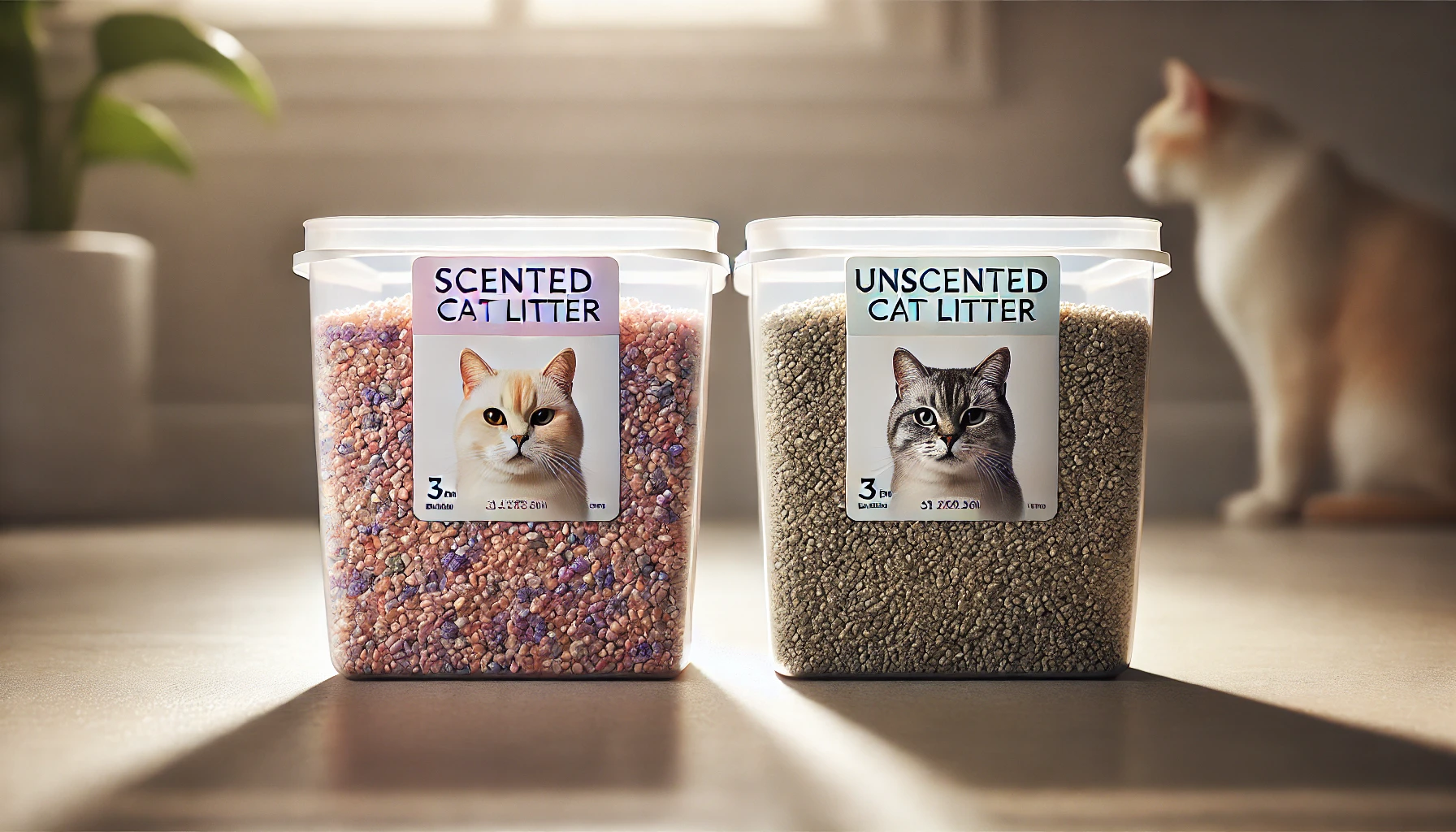
Scented vs Unscented Litter
Scented litter can be valuable for masking unpleasant odors, but your cat’s preferences are equally important.
Some cats may be sensitive to artificial fragrances present in scented litters, which could deter them from using the box.
If your cat seems to be avoiding the litter box, switching to unscented litter might help.
While unscented litter lacks the odor-masking properties of scented litter, regular cleaning and proper maintenance should keep the area smelling fresh without the need for additional scents.

Natural and Eco-Friendly Options
Many cat owners have become more environmentally conscious with the products they use, and cat litter is no exception.
Recycled paper, wood pellets, or corn-based litters offer biodegradable alternatives to clay-based litters.
These types of litter may also be gentler on your cat’s paws and help reduce dust in your home, making them great options for cats or owners with sensitivities.
However, many natural litters won’t clump as well as clay-based ones.
- Recycled Paper: Soft, biodegradable, ideal for cats with sensitive paws.
- Wood Pellets: Natural, dust-free, and absorbent, with a mild scent.
- Corn-Based Litter: Biodegradable and clumping, but it may attract insects if not stored properly.
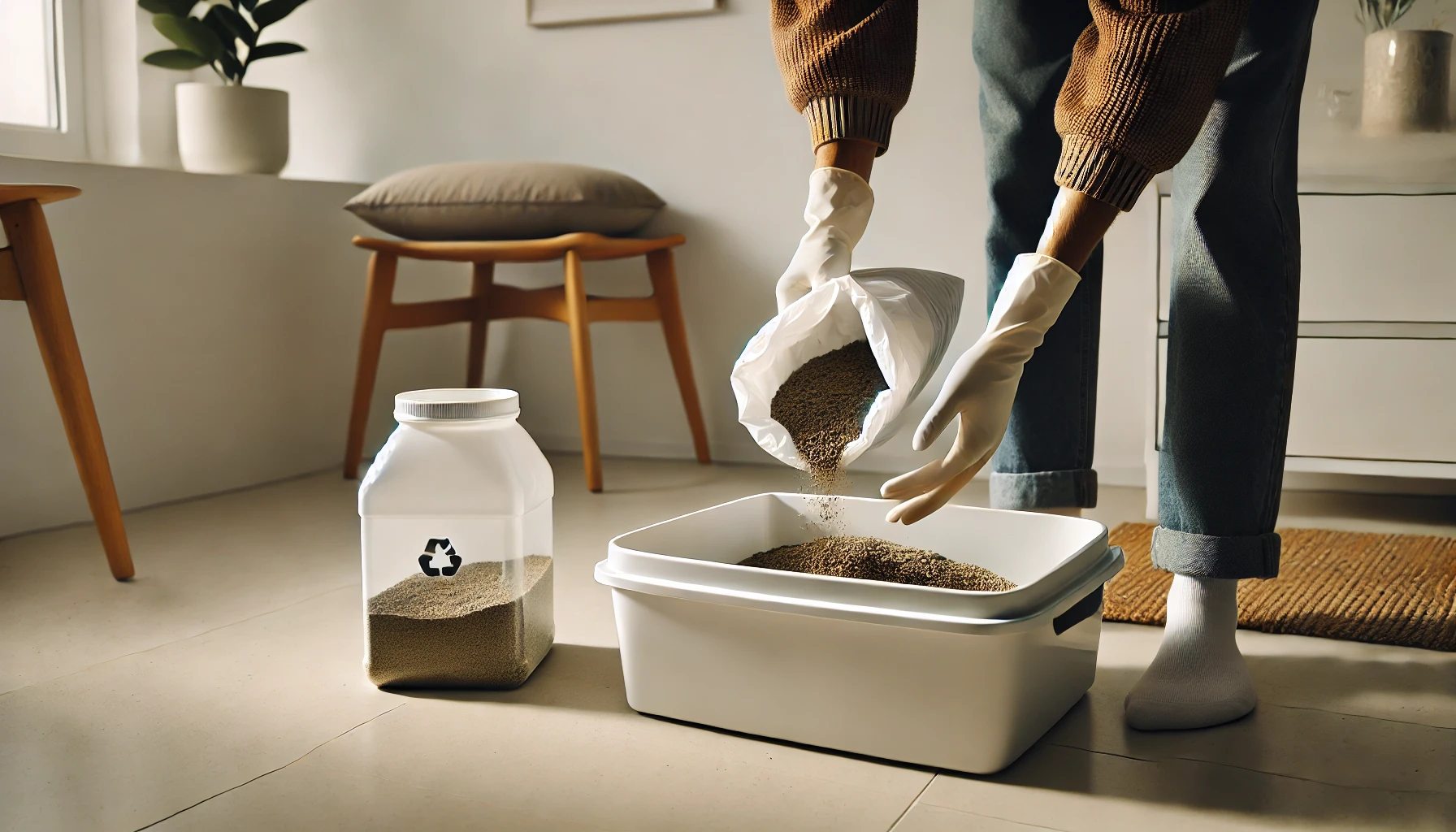
Frequency of Changing Litter
No matter the type of cat litter, the frequency of changing it is crucial for keeping your cat in an odor-free environment.
Generally, clumping litters don’t require full changes as often since you remove waste daily.
Non-clumping litters, however, may need to be replaced entirely more frequently.
As a general rule, aim to fully replace your cat’s litter at least once a week, though the number of cats you have and the type of litter in use may affect this schedule.
By selecting the right cat litter, you can save yourself a lot of time and effort on cleaning while ensuring your cat remains happy and comfortable.
Be attentive to your cat’s preferences, and don’t hesitate to try different types of litter until you find the best fit for both you and your feline friend.
The choice between clumping and non-clumping litter depends on ease of cleaning and budget. Clumping litter makes daily scooping easier, while non-clumping litter may require more frequent replacement.
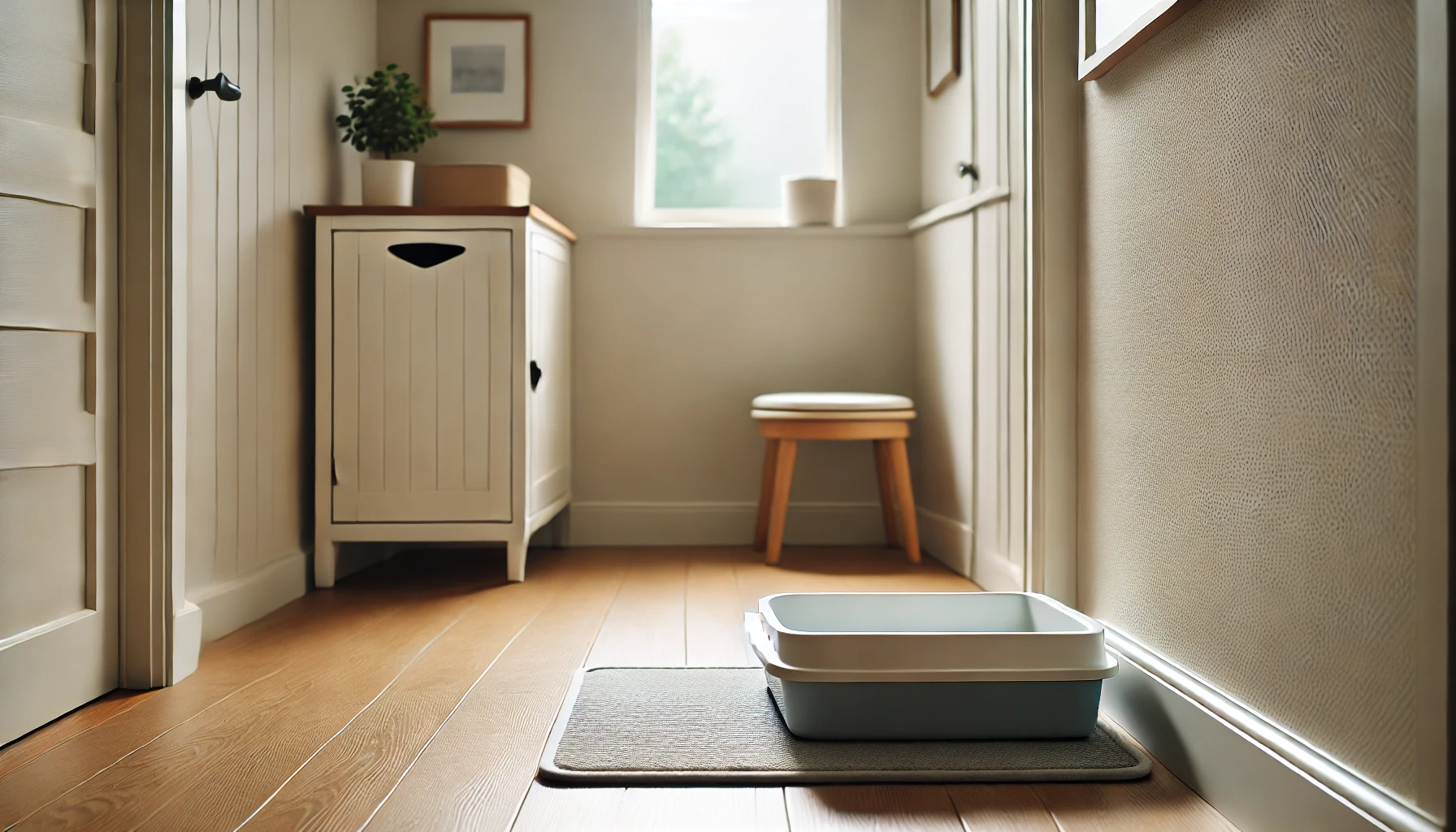
Litter Box Placement Tips for a Hygienic Environment
The litter box placement of your cat is as important as the type of litter or the box itself.
Cats are sensitive to their environment, and poor placement can lead them to avoid the litter box, causing hygiene problems around your home.
Choosing the right place will not only guarantee that your cat regularly uses the box but also help keep your home cleaner and free from odors.
Let’s explore the best strategies for placing litter boxes to maintain hygiene for both you and your cat.
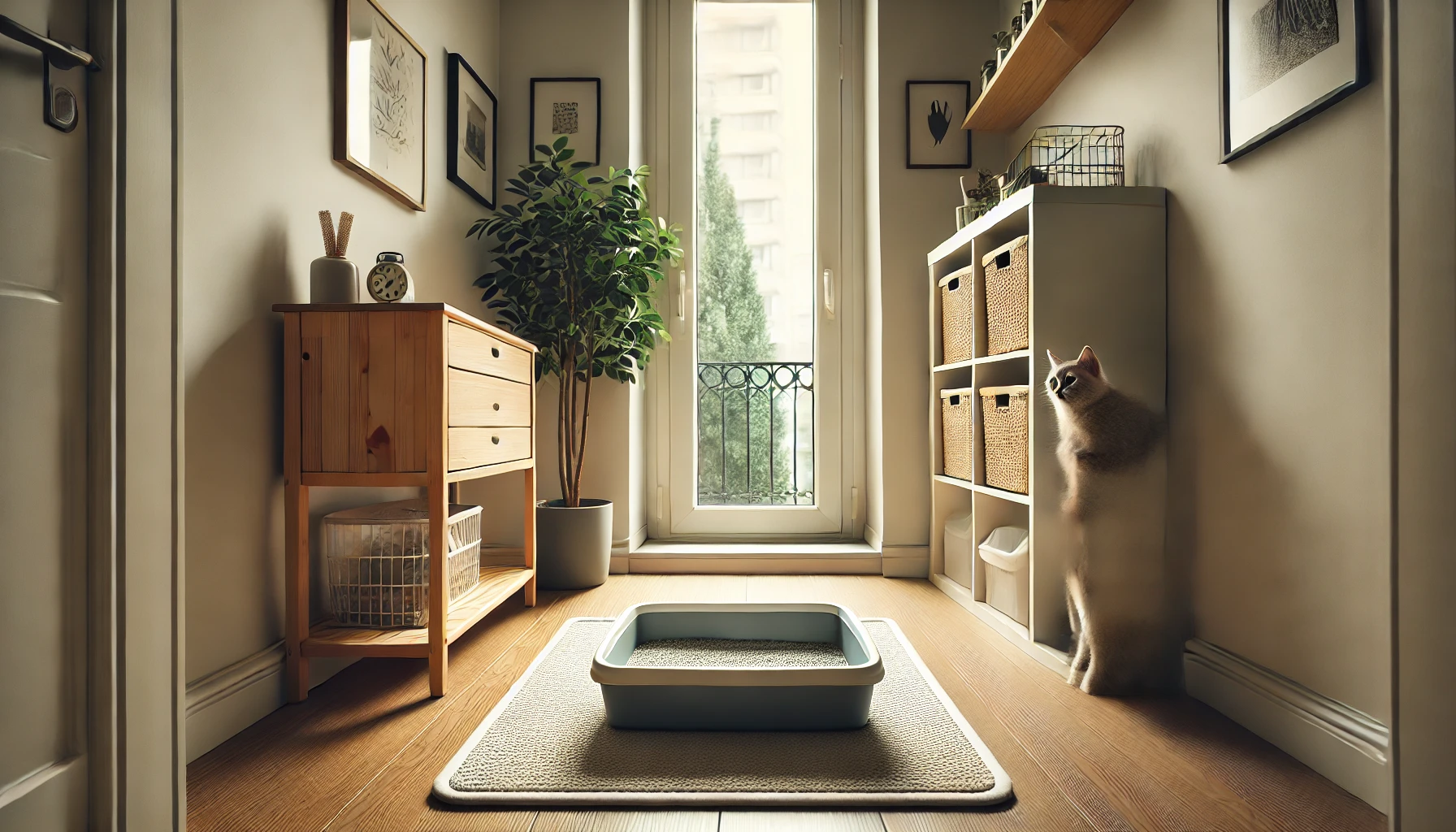
Best Places to Put a Litter Box
Like humans, cats prefer privacy when they need to use the litter box.
Placing the box in high-traffic areas or near noisy appliances can make your cat uncomfortable, leading them to avoid it.
The ideal spot is a secluded location that’s easily accessible, especially for older cats or kittens.
Avoid placing the litter box in small, enclosed spaces, like closets or under furniture, as these areas can trap odors and make it difficult for your cat to reach the box.
- Private Spaces: Place the litter box in a quiet, low-traffic area.
- Easy-to-Reach Places: Ensure the box is accessible to your cat, especially for aging cats or those with mobility issues.
- Tight Spaces to Avoid: Avoid placing the litter box in small, enclosed areas where odors can build up.

Avoiding High Traffic Areas
Your cat needs privacy while using the litter box, so place it away from areas with heavy foot traffic.
Situating the box in busy hallways, next to doors, or near loud household appliances like washing machines or dryers can make your cat feel uneasy.
Choose a location that’s out of the way but still within your cat’s daily living area to minimize the distance they need to travel to use it.
High-traffic areas can also lead to increased litter tracking, as your cat may kick litter out of the box in a hurry.
Keep the box away from areas where litter can easily spread, such as next to carpeting or doorways.
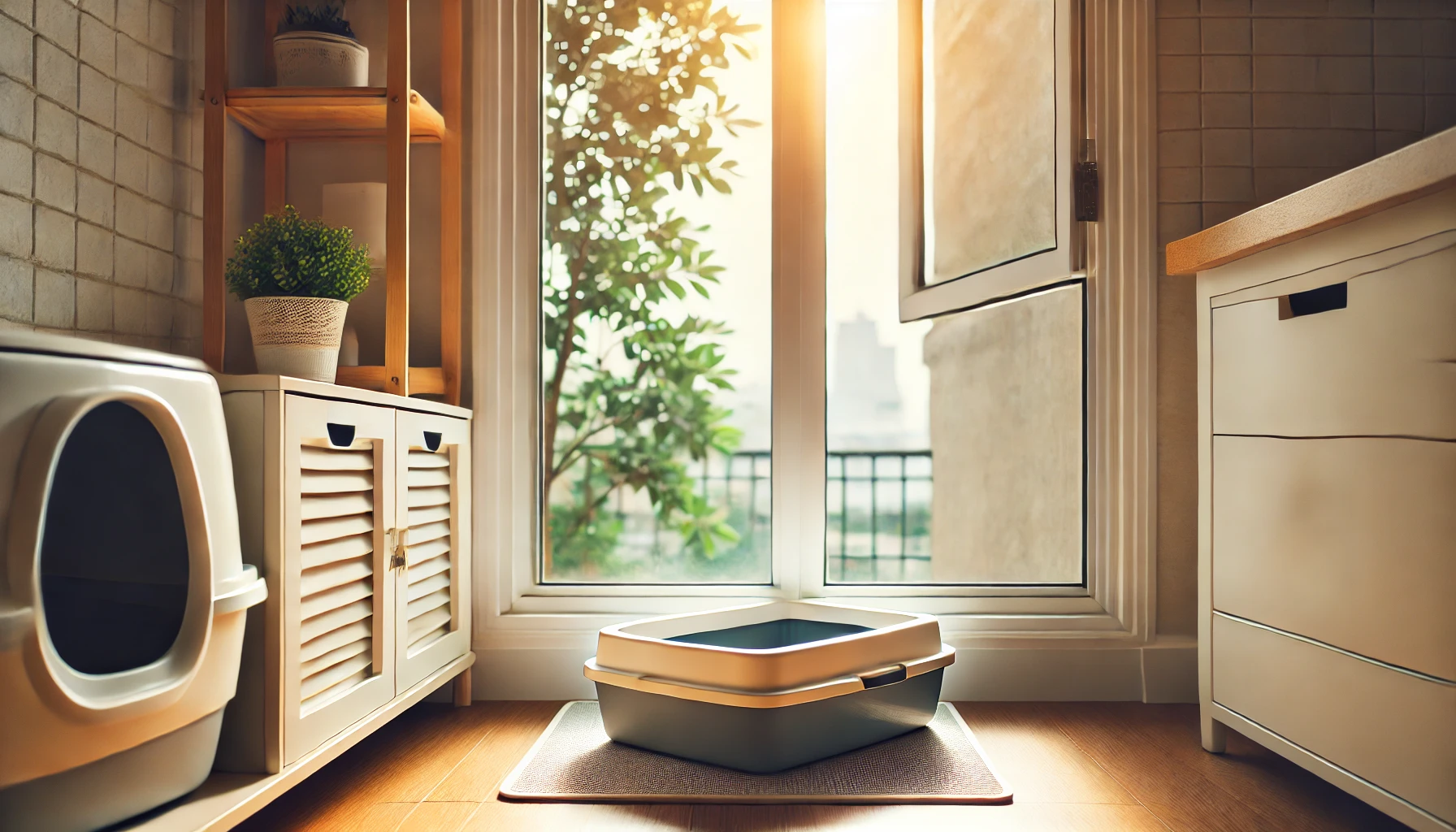
Ventilation and Odor Control
Good ventilation is key to preventing odors from building up in the litter box area.
A well-ventilated room allows unpleasant smells to disperse, creating a healthier space for both you and your cat.
If possible, place the litter box near a window or in a room with good air circulation.
You can also use air purifiers or deodorizers designed to eliminate pet odors and keep the area fresh.
- Ventilated Spaces: House the litter box in a well-ventilated area to help minimize odor.
- Air Purifiers: Consider using air purifiers or deodorizers to keep the space fresh.
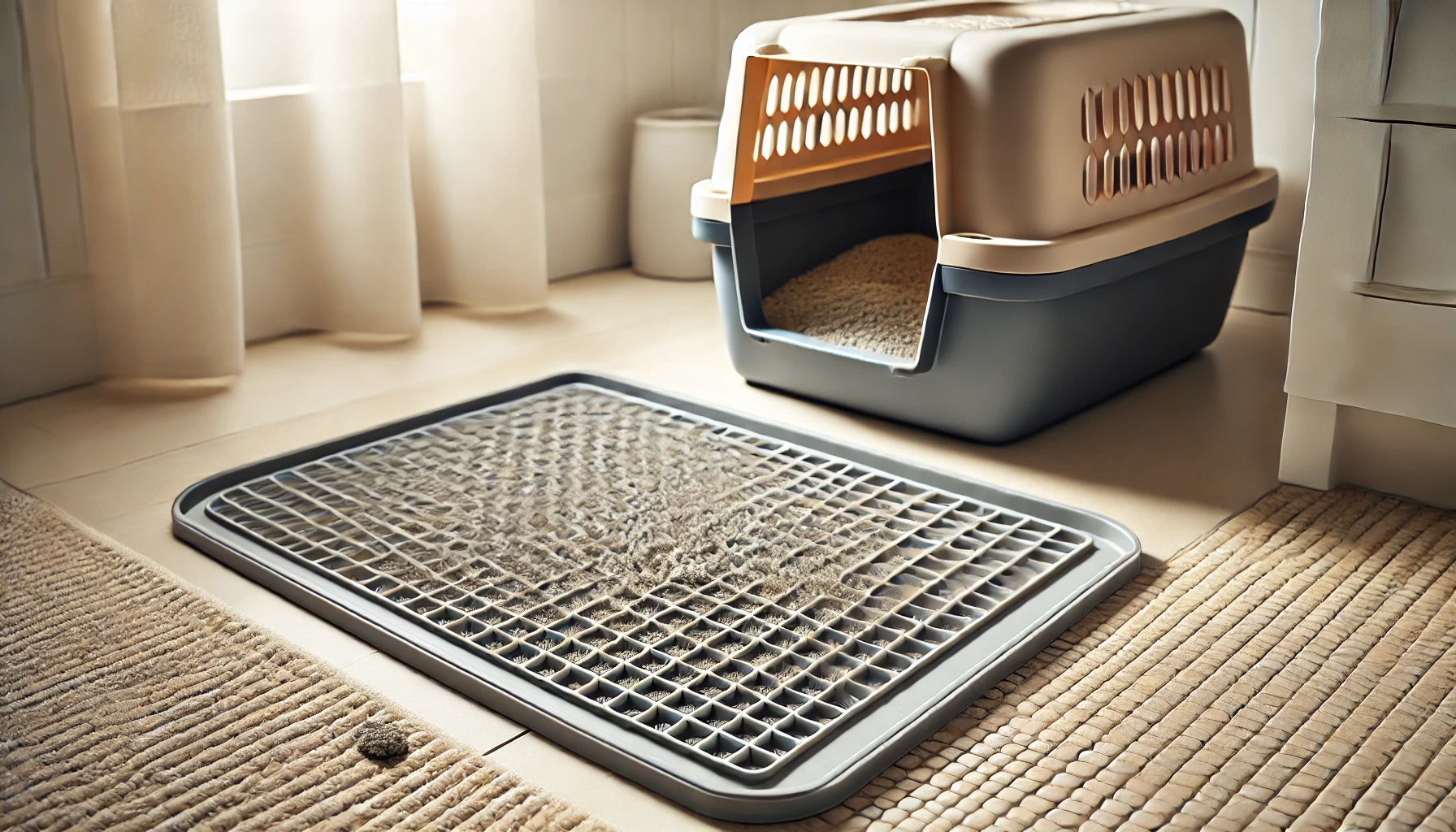
Using Mats to Reduce Litter Spread
One of the biggest challenges cat owners face is the litter being tracked out of the box.
Placing a litter-catching mat around the litter box can significantly reduce how much litter is spread across the floor.
These mats are made of rubber or other materials designed to trap litter and keep it contained.
Be sure to choose a mat that is large enough to cover the area around the box, especially if your cat tends to kick litter out when digging.
- Litter Mats: Place mats under or around the litter box to catch and hold litter.
- Easy-to-Clean Material: Look for a mat that can be easily shaken out or cleaned regularly.
Proper placement of your cat’s litter box contributes to a cleaner, more hygienic environment for your cat and reduces litter tracking and odor in your home.
Your cat’s comfort should be the most important factor in maintaining their litter box habits, so always take their preferences into consideration.
Proper placement in quiet, well-ventilated areas can reduce stress for your cat and maintain hygiene. Avoid placing the litter box in high-traffic or confined spaces.
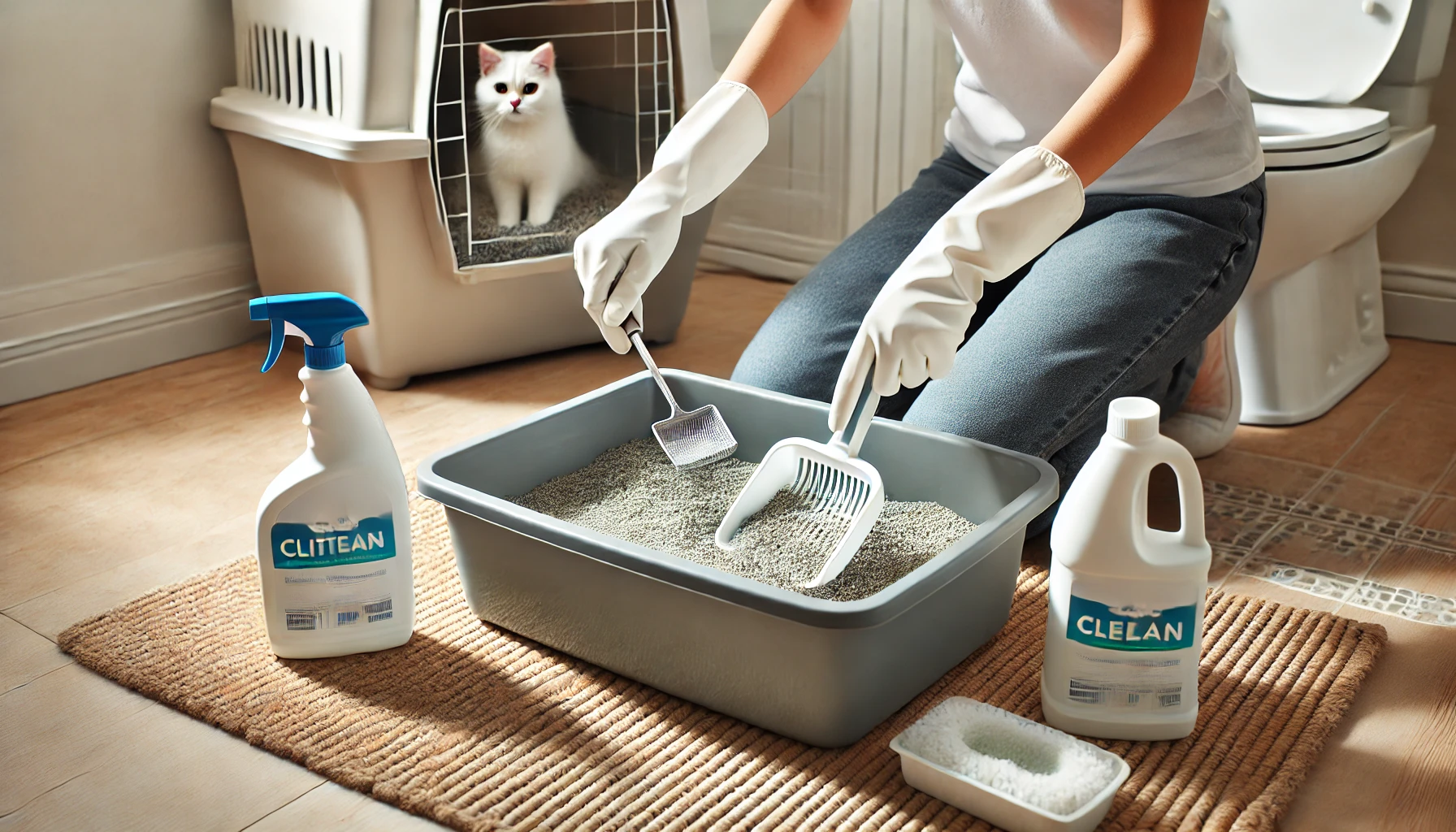
Daily and Weekly Litter Box Cleaning Routines
A daily and weekly cleaning routine is essential to keep your cat’s litter box area clean and hygienic.
Cats are meticulous animals and will avoid using a dirty litter box.
By establishing a daily and weekly litter box cleaning schedule, you will be able to maintain fresh litter, keep unpleasant odors out of your home, and ensure that your cat has no issues using the box.
Now, let’s dive into the most important practices for cleaning the litter box on a daily and weekly basis.
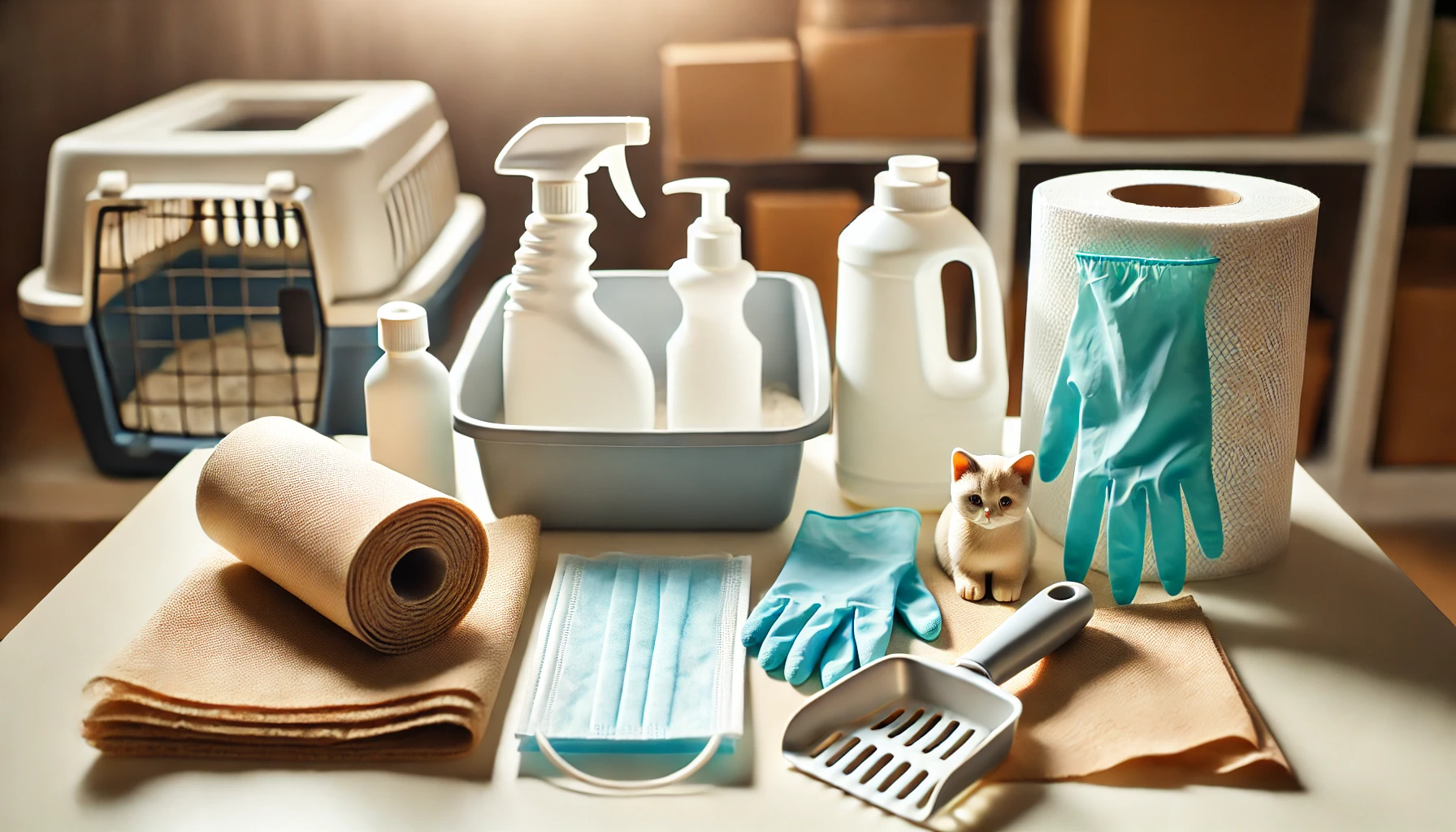
Materials Needed to Clean
Having the right tools before starting the cleaning process makes it more efficient.
The basic equipment you’ll need for daily and weekly litter box cleaning includes:
- Litter Scoop: A sturdy scoop for removing clumps and waste daily.
- Gloves: Disposable or reusable gloves to keep odors from attaching to your hands.
- Trash Bags: Keep bags handy for easy disposal of waste and used litter.
- Enzymatic Cleaner: A pet-safe, non-toxic enzymatic cleaner for stain removal and odor reduction.
- Paper Towels or Cloth: Used for wiping down the litter box during deep cleaning.
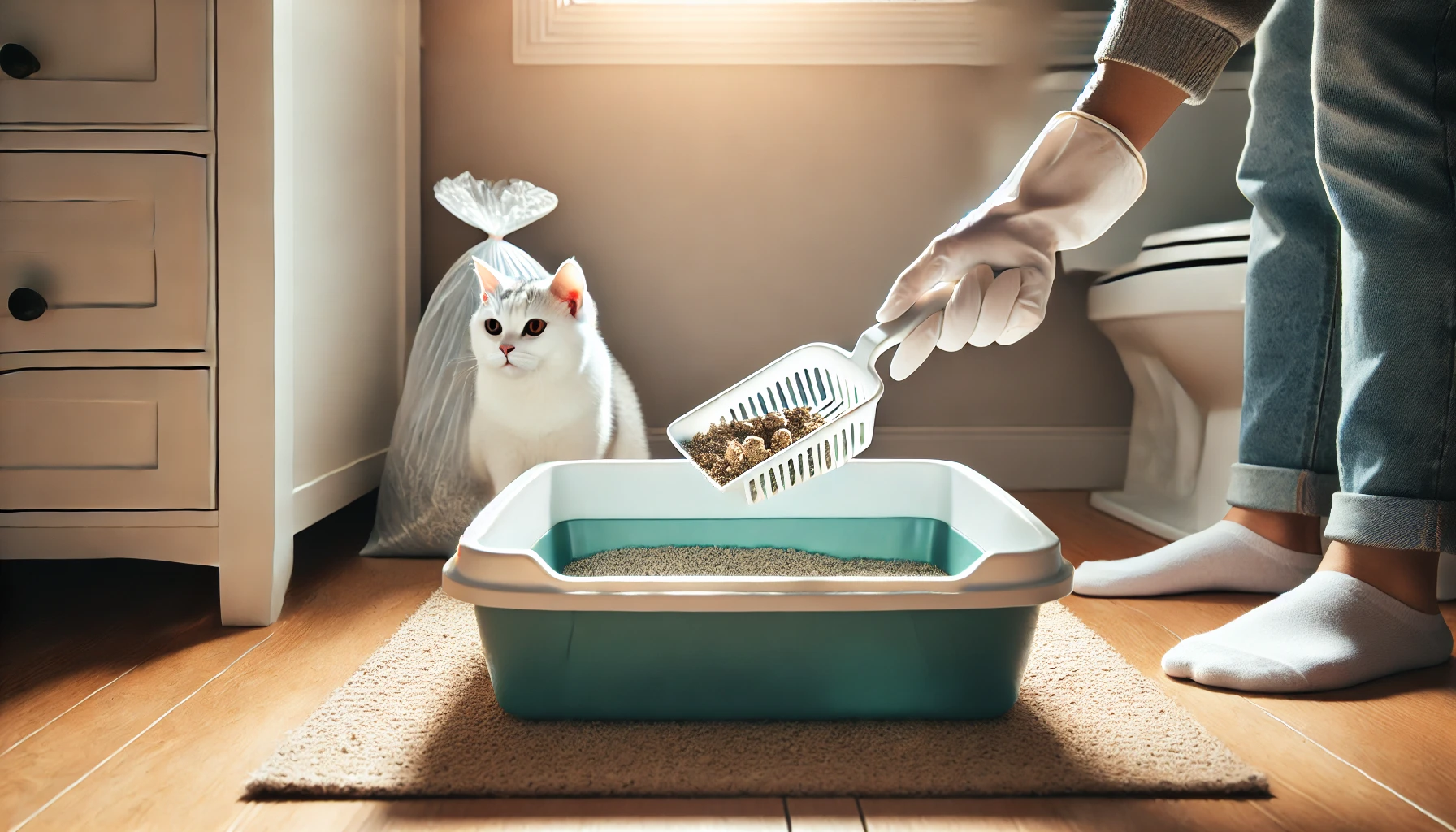
Daily Scooping and Waste Removal
Scooping should be done daily to keep the litter box clean and hygienic.
Cats are clean animals and prefer a litter box free of waste.
Every day, scoop out clumps of urine and feces using a litter scoop.
Place the waste in a sealed trash bag to reduce odors.
After scooping, stir the remaining litter to even it out and prevent wet spots from forming.
Regular scooping extends the life of the litter, so you won’t need to change it as frequently.
In households with multiple cats, it’s best to scoop several times a day to ensure the litter box remains clean and odor-free.
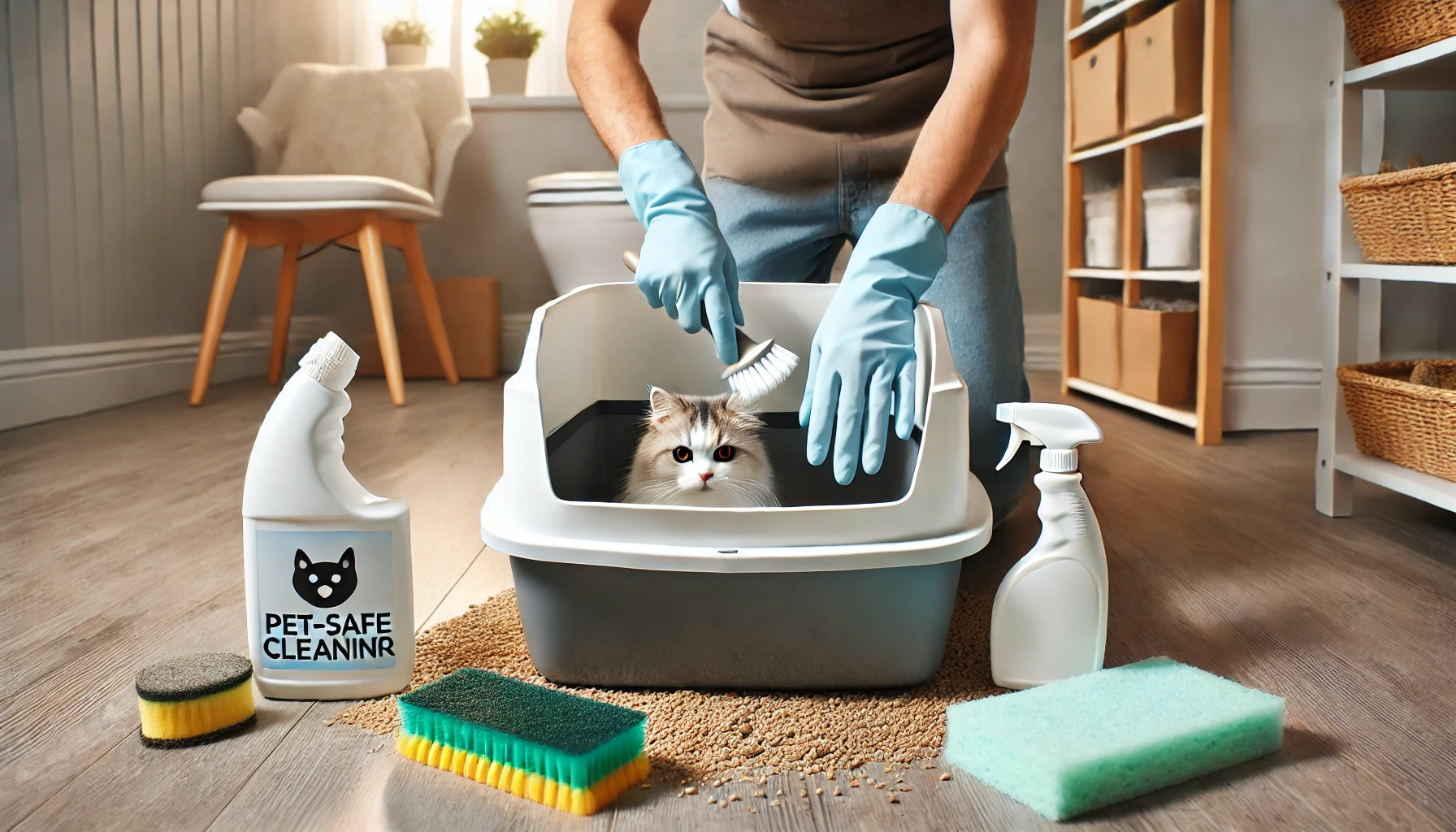
How to Do Deep Cleaning of the Litter Box on a Weekly Basis
While daily scooping keeps the litter box clean, deep cleaning once a week is necessary to maintain its condition.
Once a week, remove all the litter from the box and dispose of it.
Wash the litter box with warm water and mild, unscented soap.
Avoid harsh chemicals, as their smell might deter your cat from returning to the box.
Rinse the box thoroughly and let it air dry completely before adding fresh litter.
If your cat scratches at the sides of the box or if there are lingering odors, consider using an enzymatic cleaner to remove stains and odors.
These cleaners break down the organic matter that causes odors, leaving the box smelling fresh.
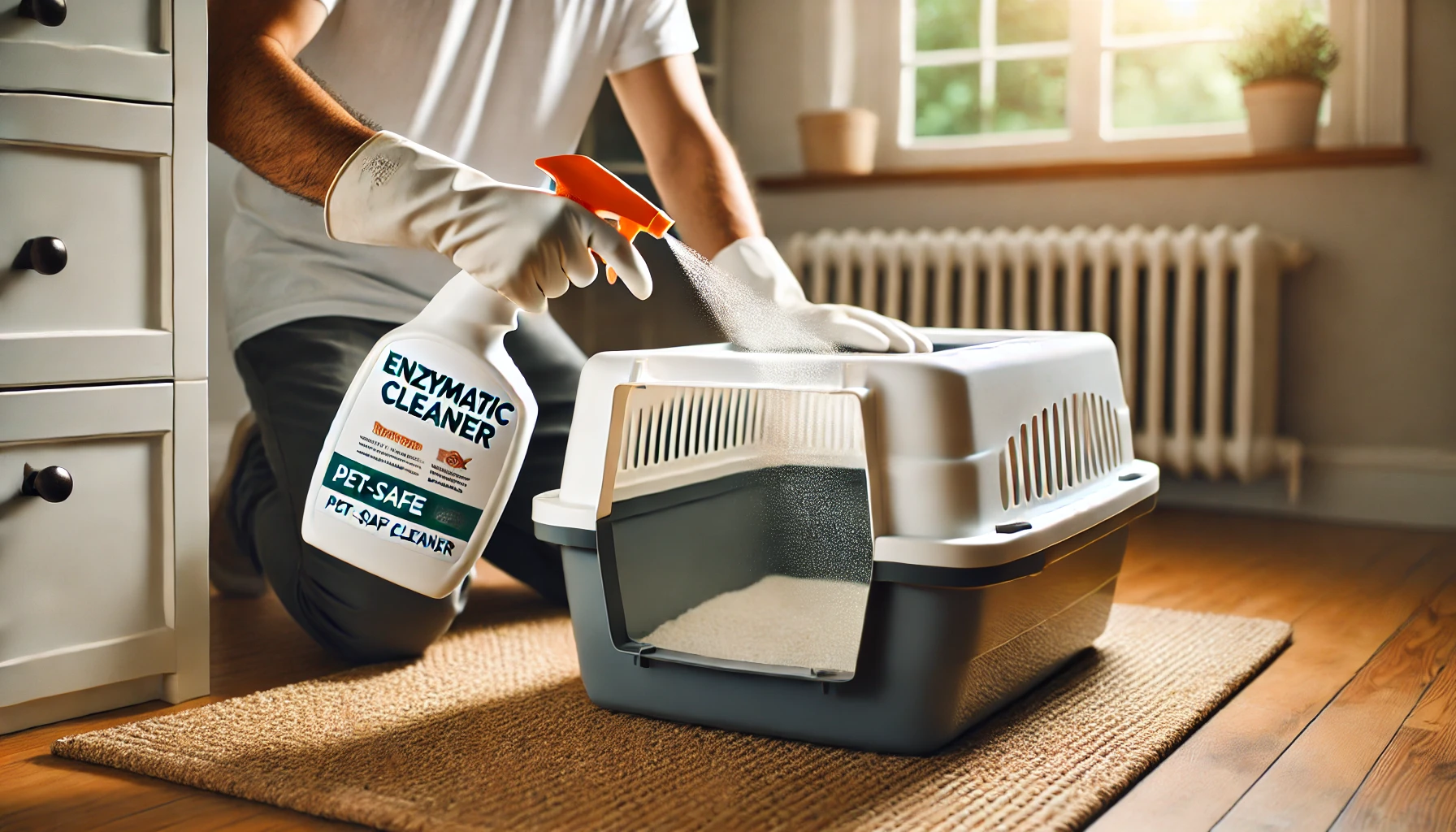
Using Enzymatic Cleaners for Odor Control
Odor control is a major concern for most cat owners.
Even with regular cleaning, lingering smells can sometimes be an issue.
Enzymatic cleaners are an effective solution for eliminating tough odors.
These cleaners use natural enzymes to break down odor-causing substances, like urine and feces.
After cleaning the box, spray the enzymatic cleaner on the surfaces and let it sit for a few minutes before wiping it down.
This helps ensure that hidden smells are neutralized, keeping your litter box area fresh.
- Choose Pet-Safe Enzymatic Cleaners: Ensure the cleaner you select is non-toxic and safe for cats.
- Target Stains and Odors: Focus on areas with stubborn stains or lingering odors.
By following a consistent daily and weekly cleaning routine, you can keep the litter box area neat and hygienic for your cat.
This will reduce odors, encourage your cat to use the litter box regularly, and ultimately create a happier environment for both you and your pet.
Daily scooping and weekly deep cleaning are essential to maintain hygiene. Neglecting these routines can lead to odors and your cat avoiding the litter box.
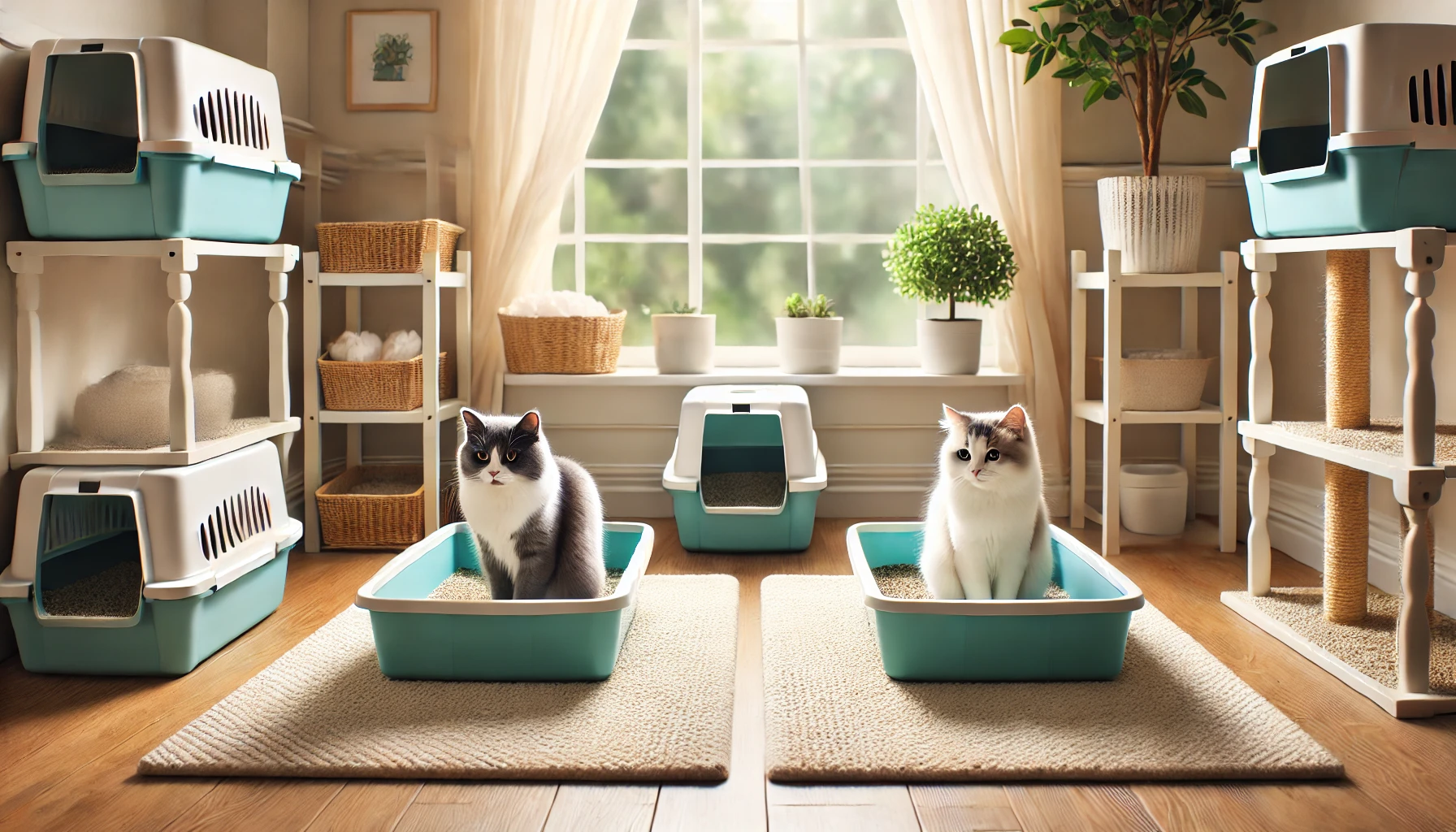
Managing Litter Box Hygiene When You Have More than One Cat
Having more than one cat can present a challenge when it comes to maintaining litter box hygiene.
This is not only because you have to deal with extra cleaning, but also because you need to ensure all of the cats remain comfortable enough to use the litter boxes available.
Cats are territorial by nature, and conflicts regarding the litter boxes could lead to behavioral problems such as house soiling.
To avoid such issues and ensure the environment remains clean and hygienic, it’s important to follow key guidelines when managing litter boxes for multiple cats.
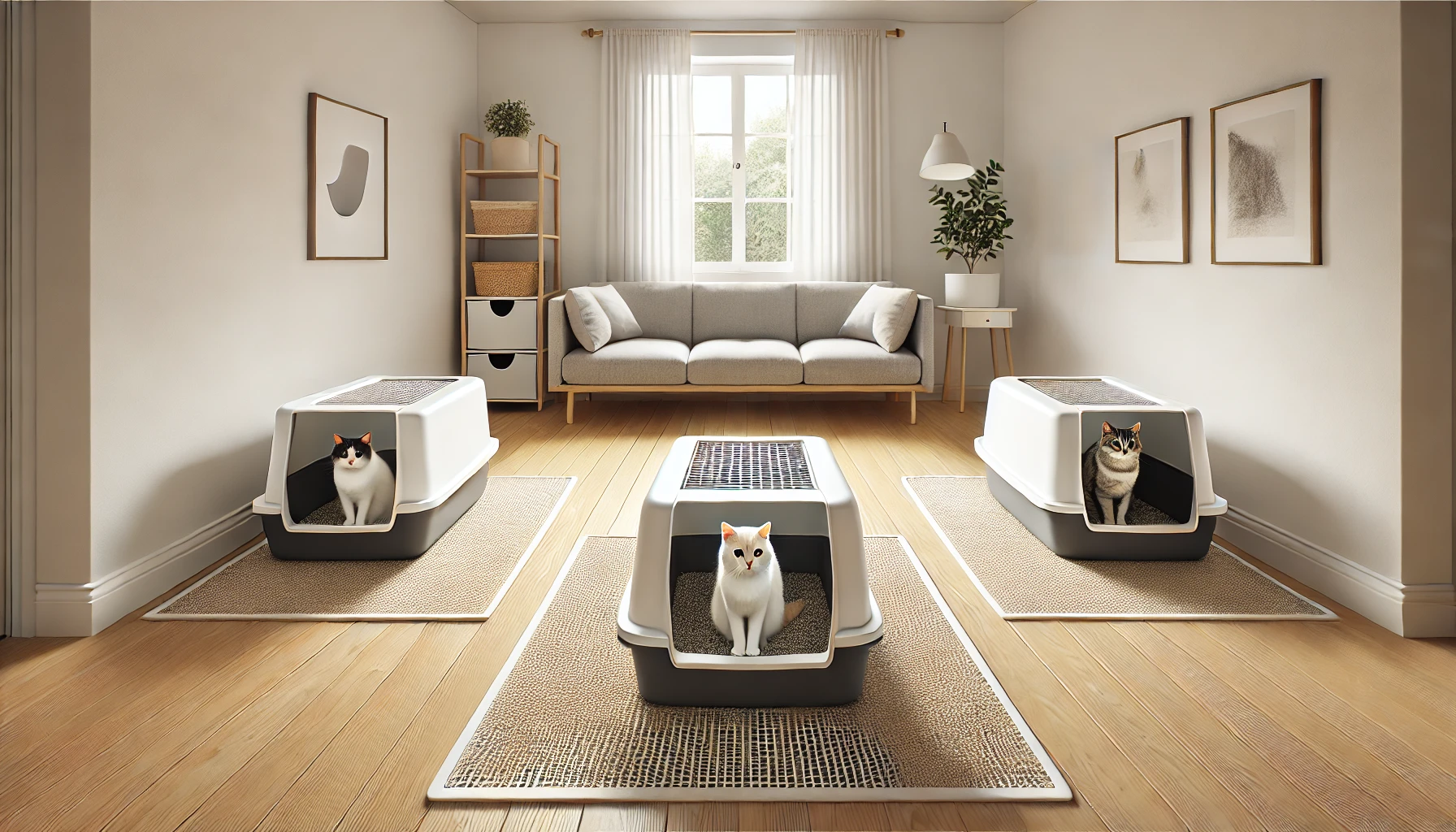
How Many Litter Boxes Should You Have?
One of the golden rules in multi-cat households is to have one litter box per cat, plus one extra.
This ensures no cat will ever feel like they don’t have access to a clean litter box.
For example, if you have two cats, you should ideally have three litter boxes.
This setup helps prevent territorial disputes and ensures that even if one box is dirty or occupied, your cats still have other options.
- 1 Litter Box Per Cat, Plus One: Ensure you have one litter box for every cat, plus one extra to eliminate overcrowding and fighting.
- Spread the Boxes Around: Place litter boxes in different areas around the house so cats can spread out, be alone if needed, and enjoy privacy.
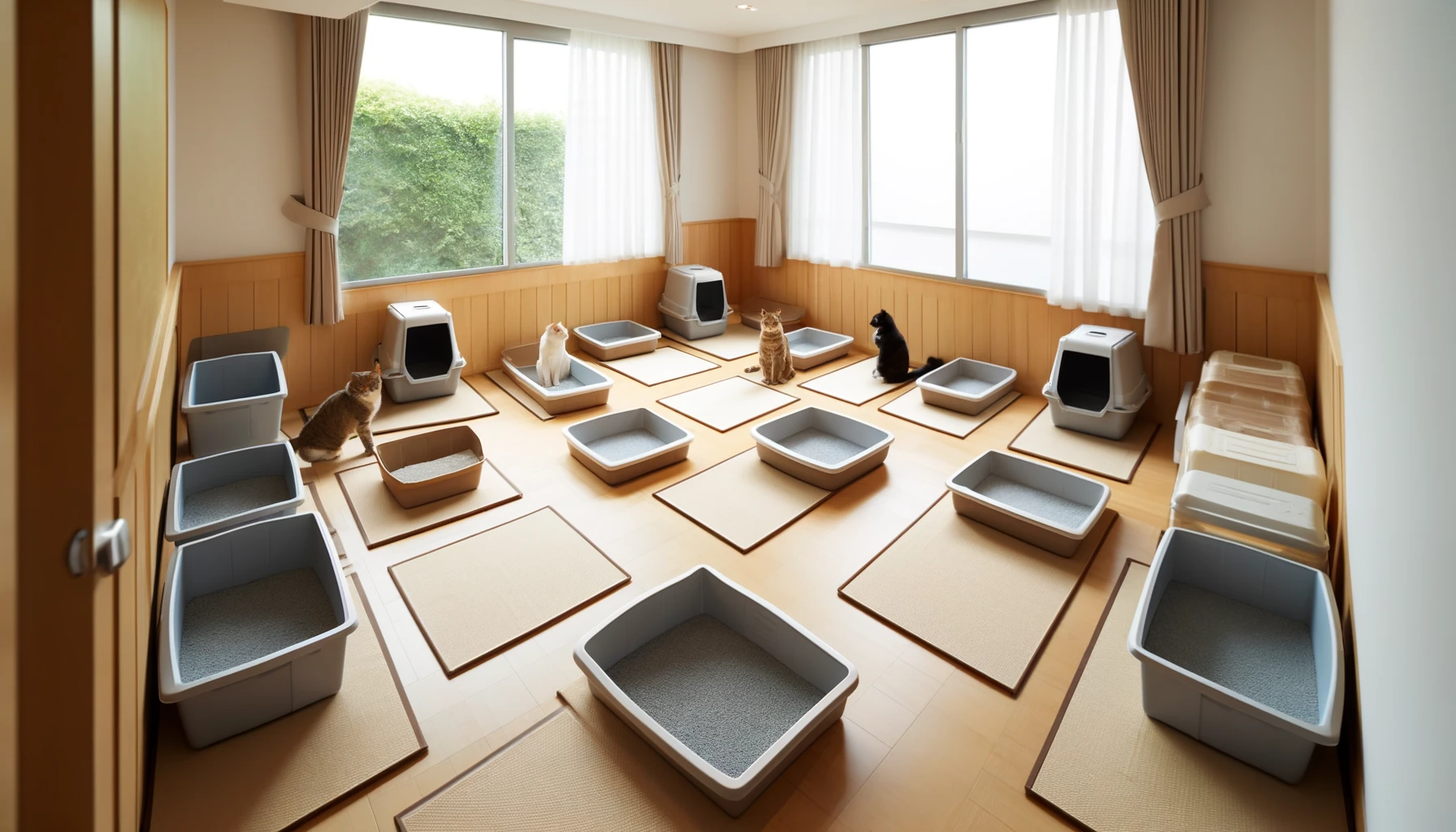
Preventing Litter Box Territorial Behavior
Cats can become territorial, especially in multi-cat households.
To reduce this behavior, set up litter boxes in various spots around your house.
Avoid placing all the boxes in one room, as this may cause one cat to dominate the space.
By spacing the litter boxes out, each cat can have their own personal area, reducing the likelihood of fights or territorial marking.
It’s equally important to place the litter boxes in quiet, accessible locations.
Cats prefer privacy, so placing the boxes in low-traffic areas will reduce stress and encourage regular use.
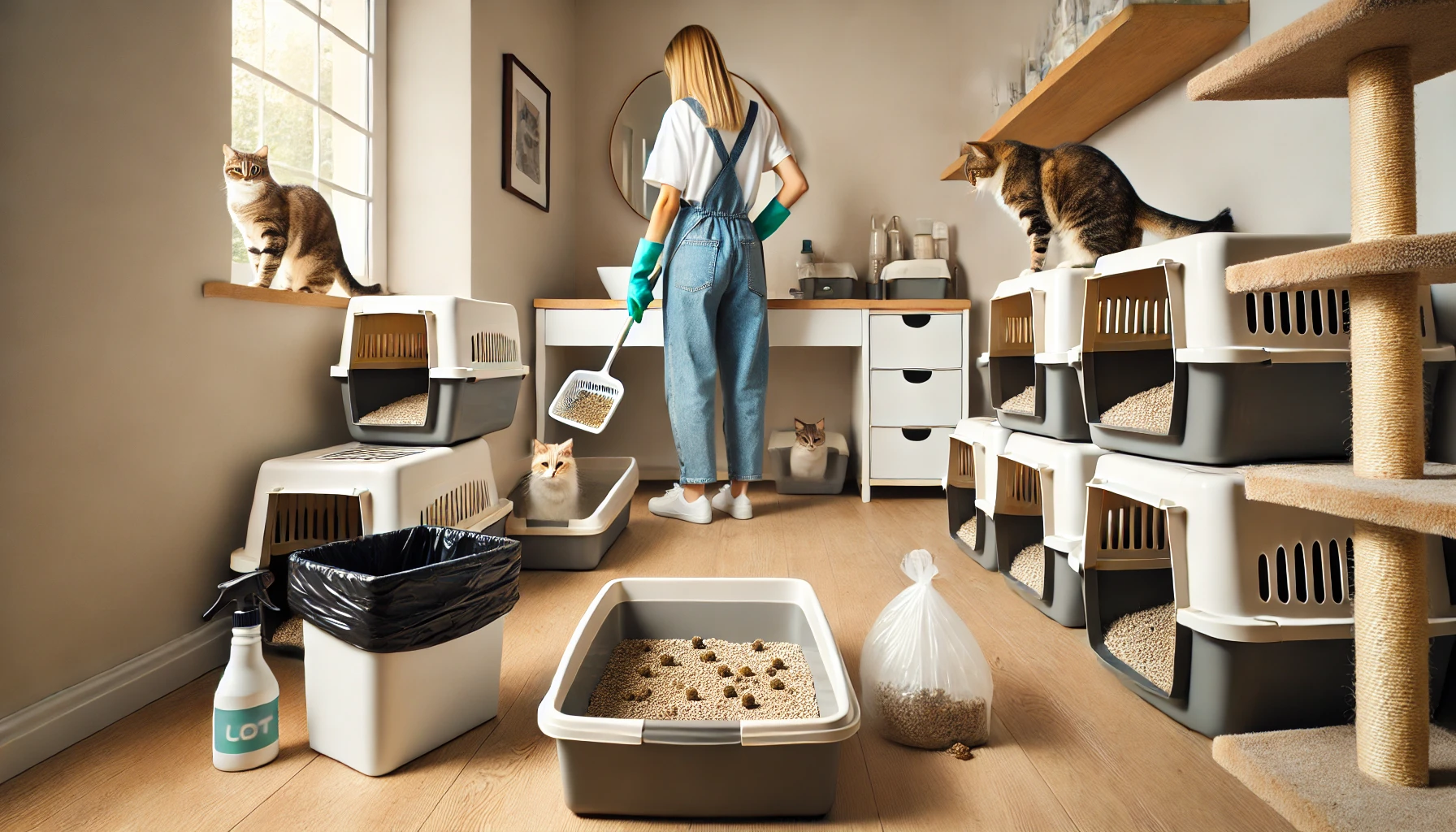
Multi-Cat House Cleaning
Cleaning the litter boxes more frequently will help minimize odors and keep your cats comfortable with multiple boxes.
The more the boxes are used, the more often you will need to clean them.
Try scooping each box at least twice a day, and consider changing the litter more often than you would in a single-cat household.
The extra cleaning effort will prevent litter box avoidance and reduce unwanted odors.
- Scoop More Often: A good rule of thumb is to scoop the litter boxes at least twice a day.
- Change Litter More Often: In a multi-cat household, you may need to replace the litter more frequently to reduce odor buildup.
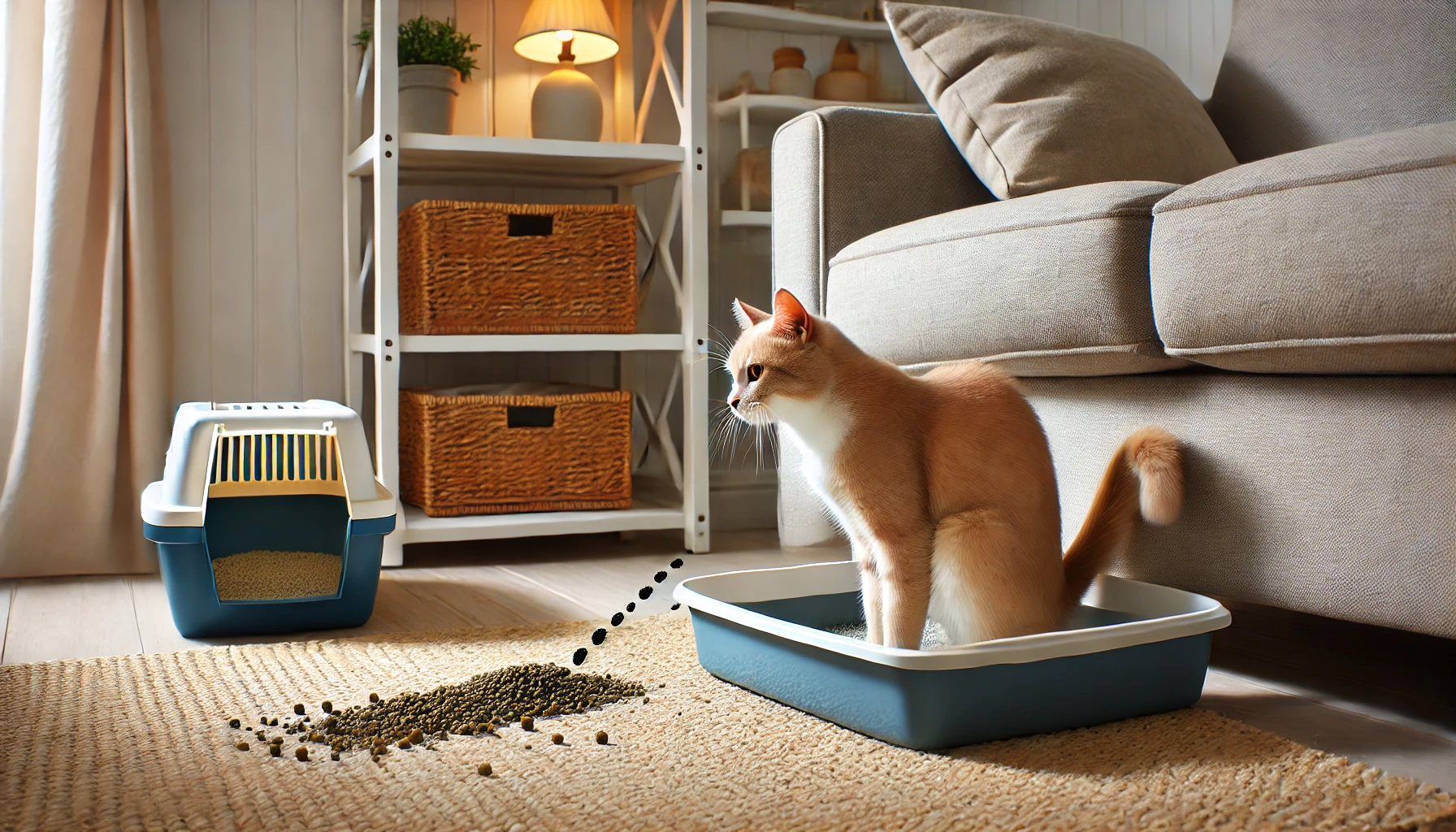
Signs Your Cat is Avoiding the Litter Box
In multi-cat households, it’s important to monitor your cats’ litter box use.
If a cat starts urinating or defecating outside the box, it may be a sign of avoidance due to cleanliness issues, territorial behavior, or stress.
Common signs of litter box avoidance include urinating in corners, on furniture, or near doors.
If you notice any of these behaviors, check the litter boxes for cleanliness, accessibility, and overcrowding.
- Urination Outside the Box: If your cat is urinating outside the box, check for cleanliness or territorial disputes.
- Minimize Stress Levels: Stress from other cats or environmental factors may be causing litter box avoidance.
By following these guidelines, you can manage litter box hygiene in multi-cat households and create a more comfortable and harmonious environment for your pets.
Proper hygiene, spreading out the boxes, and monitoring your cats’ behavior are key to preventing litter box issues and maintaining cleanliness.
Ensure you have enough litter boxes for multiple cats to prevent territorial disputes. Follow the 1 litter box per cat plus one extra rule for a harmonious environment.
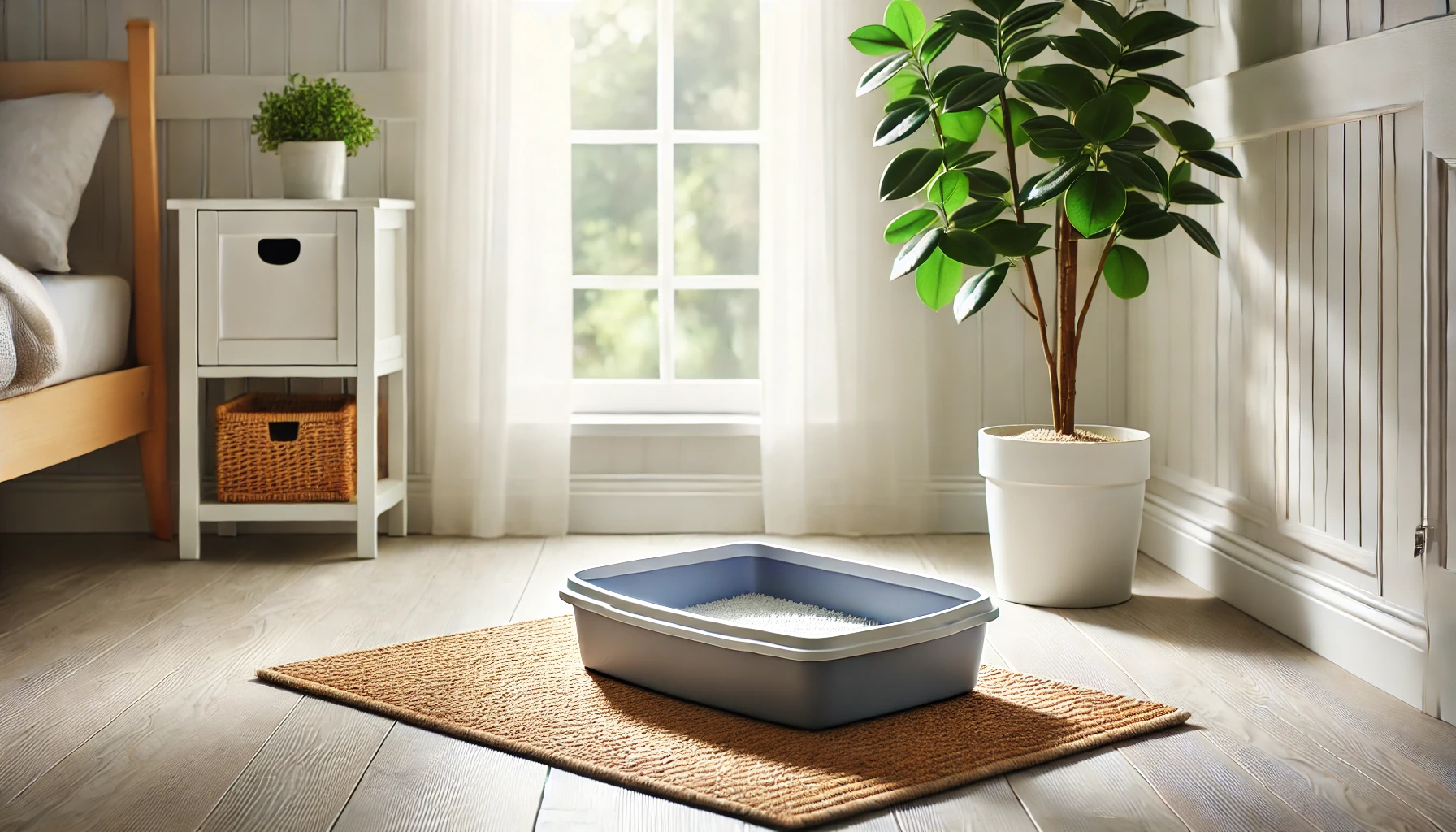
Conclusion to Keeping the Litter Box Area Clean and Sanitary for Cats
Maintaining a clean and hygienic litter box environment is important both for your cat’s health and the overall cleanliness of your home.
By following best practices for managing the litter box, you can ensure that your cat has an odor-free, comfortable space while keeping your home fresh and tidy.
Let’s summarize how to keep litter box areas tidy and hygienic for cats.
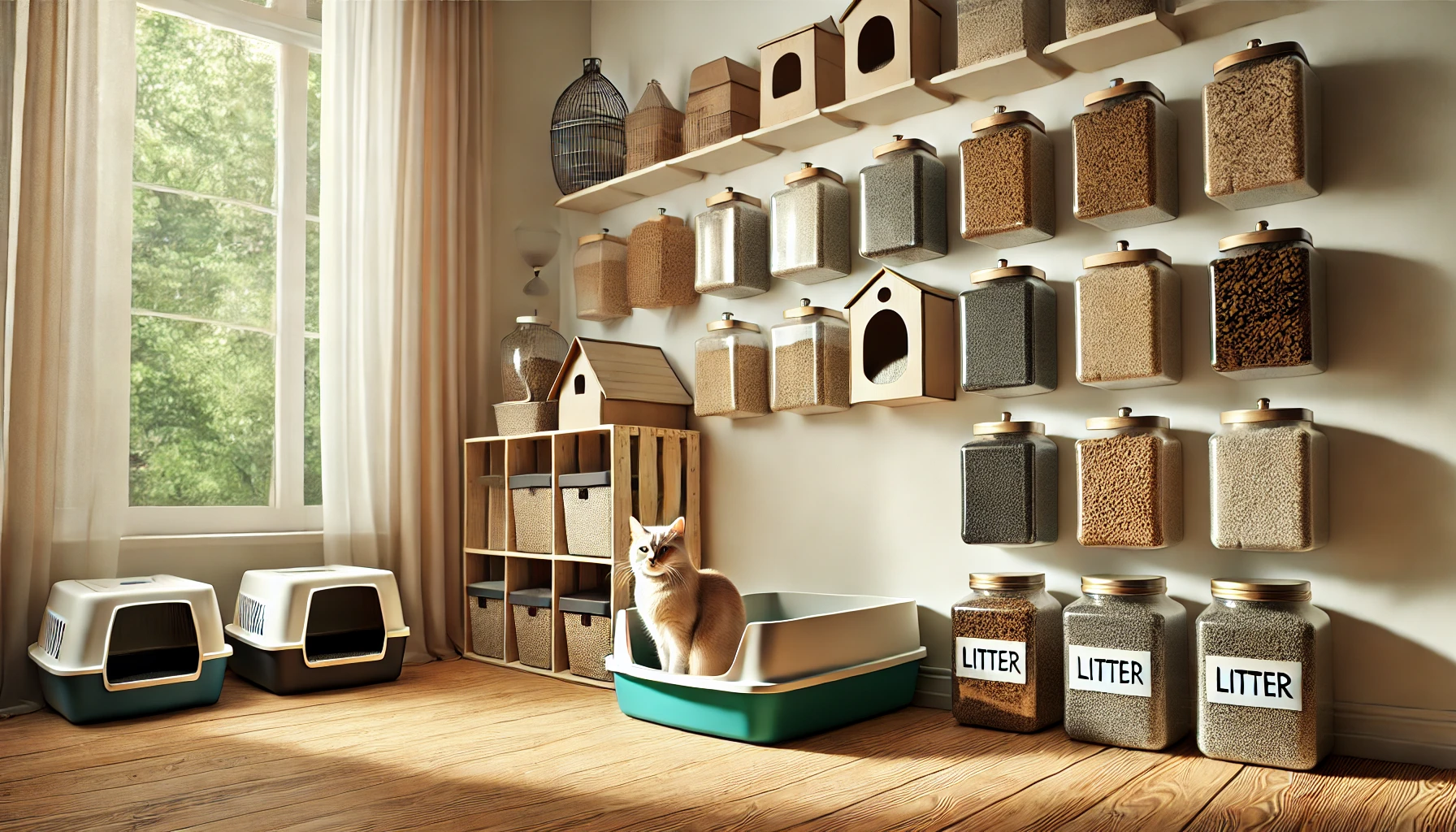
How to Choose an Appropriate Litter Box and Type of Litter
Everything starts with selecting the right litter box and the most suitable type of litter your cat will prefer.
When it comes to litter boxes, size really matters—choose a box large enough to allow your cat to move comfortably.
Additionally, decide whether a covered or uncovered box is best suited to your cat’s preferences.
Clumping litter is generally the easiest for regular scooping, but other types may be more budget-friendly.
Consider your cat’s unique needs when making these decisions.
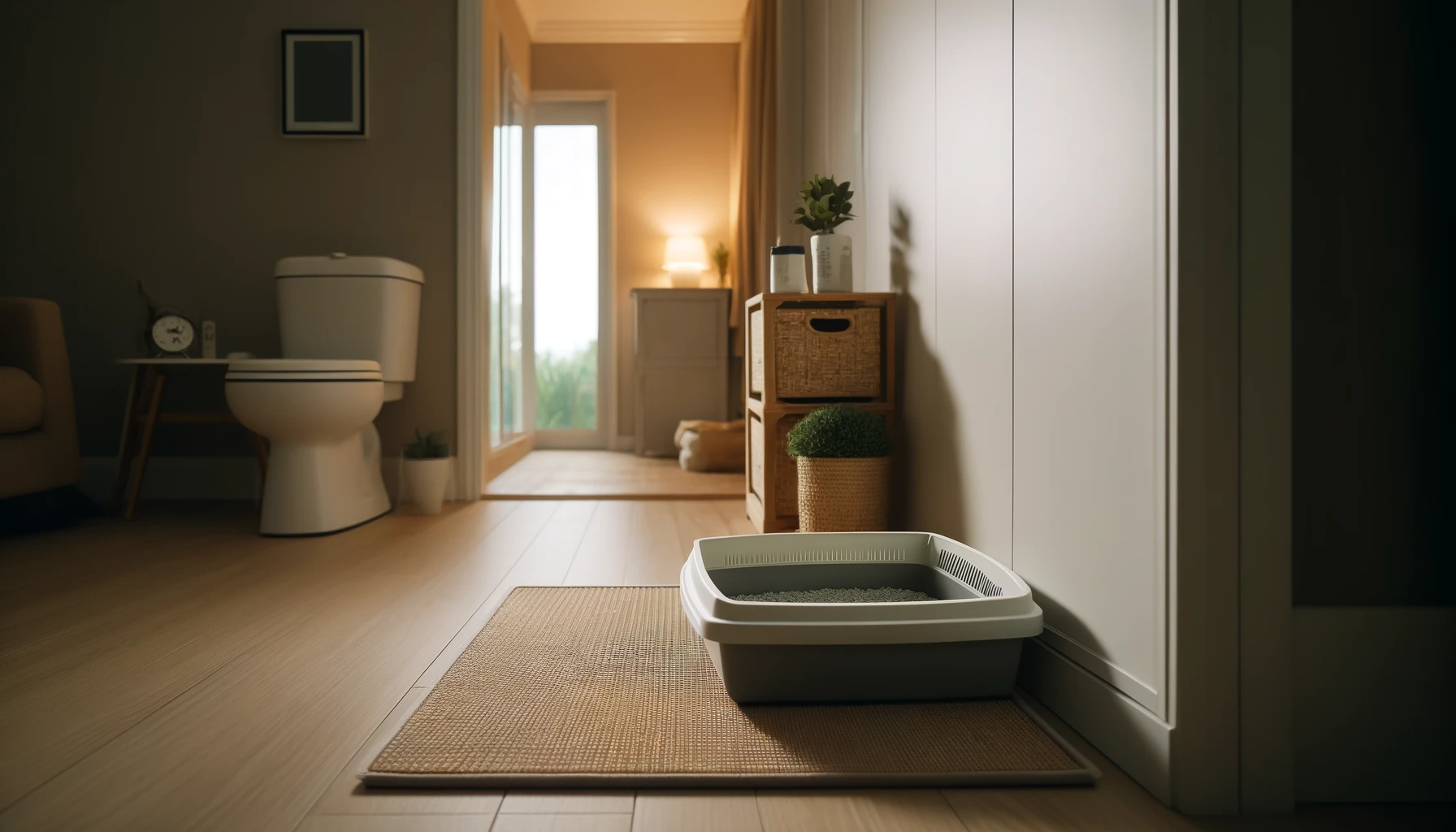
Where to Put the Litter Box
Quiet, private locations away from high-traffic areas will encourage your cat to use the litter box consistently.
Avoid placing the litter box in small, confined spaces where odors can collect.
Good ventilation is key to keeping the litter box area fresh and providing a clean environment for your cat.
Using mats around the litter box will help reduce litter tracking and keep your floors clean.
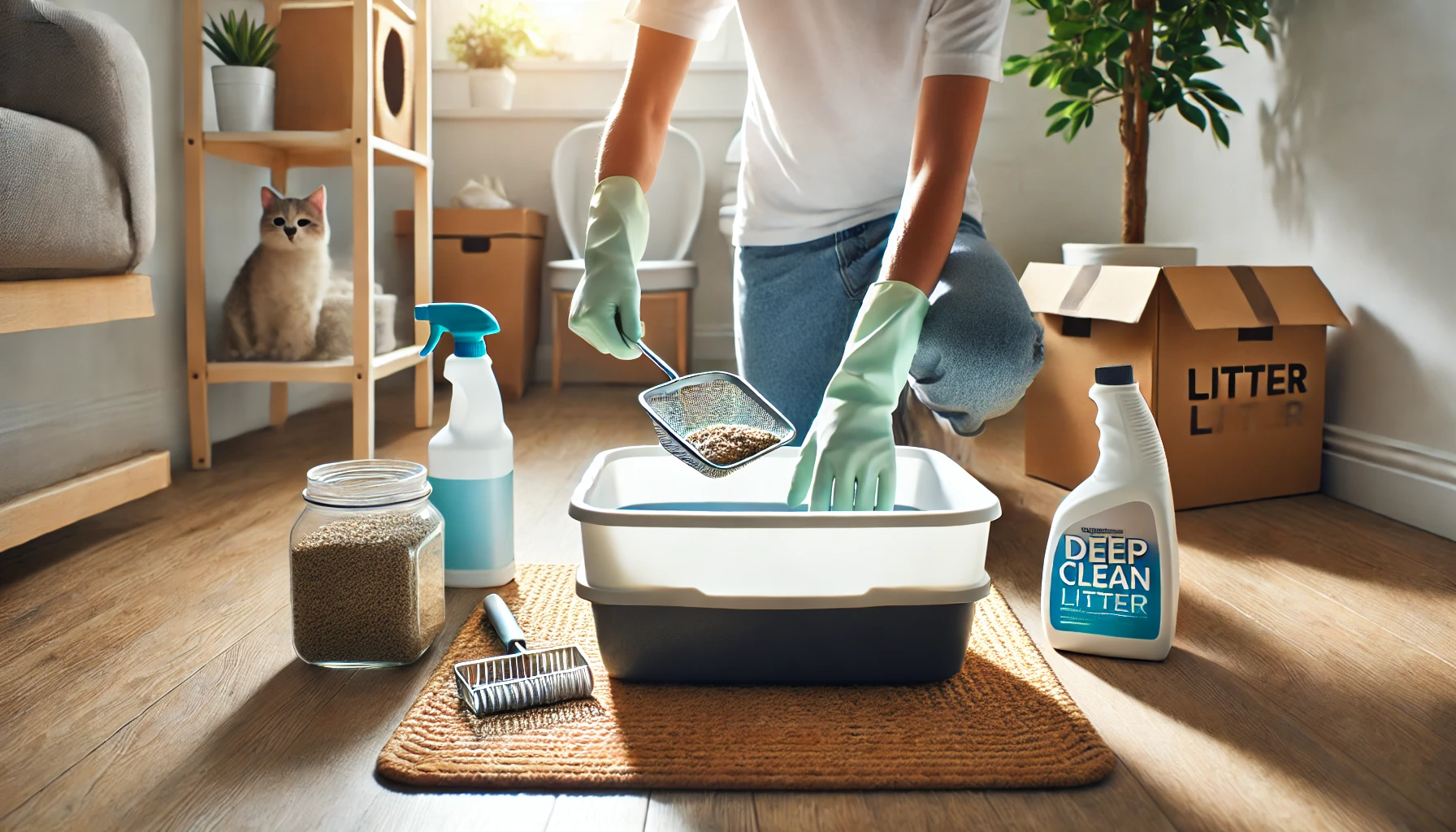
Daily and Weekly Cleaning Routines
A regular cleaning schedule is the foundation of litter box hygiene.
Daily scooping prevents waste buildup, making the litter box more appealing to your cat and reducing odors.
A weekly deep cleaning, including washing the box and replacing the litter, keeps it in optimal condition.
Using pet-safe enzymatic cleaners helps with odor control and ensures the box stays fresh.
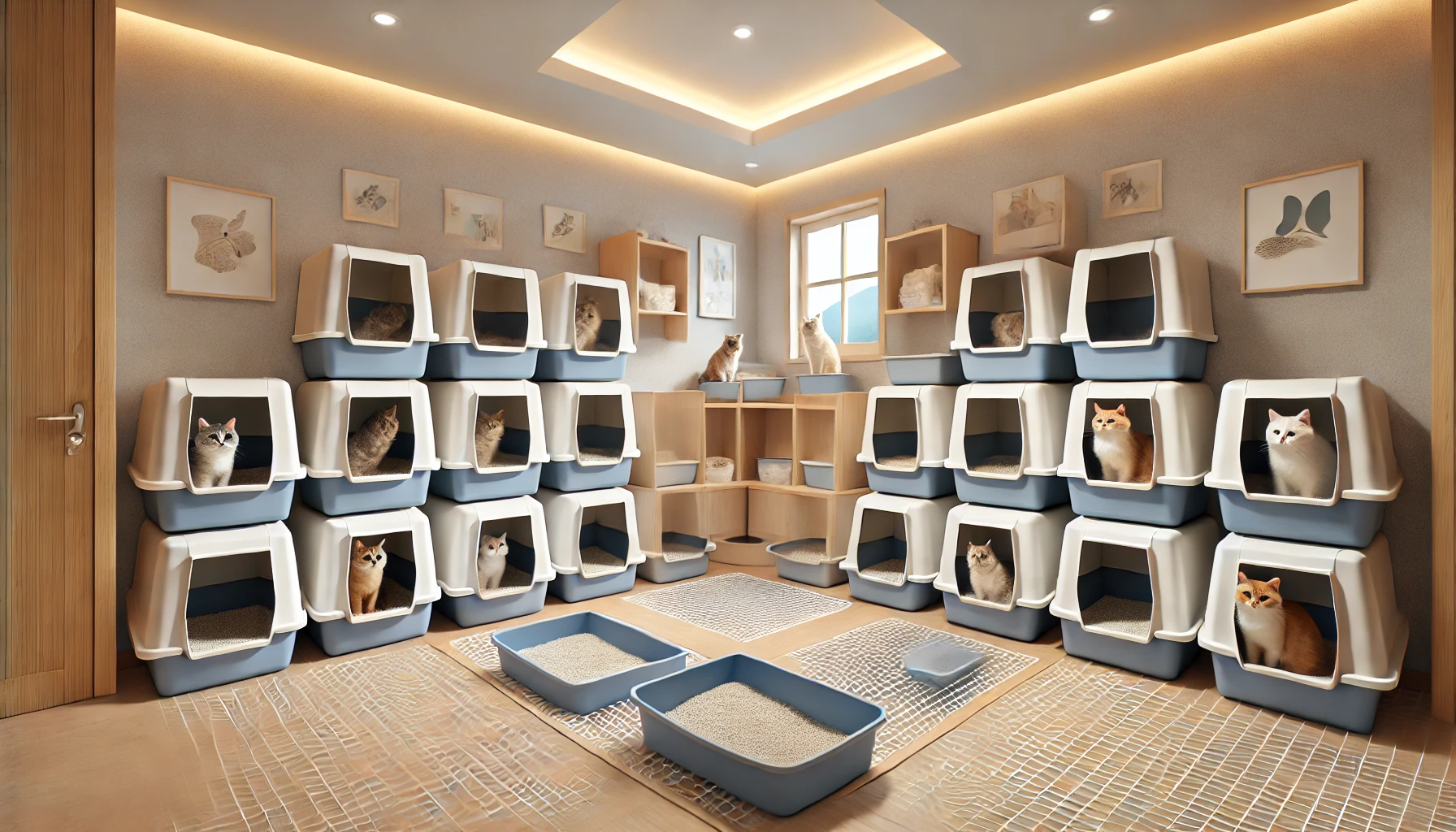
Litter Box Hygiene in Multi-Cat Households
Litter box hygiene becomes even more important in multi-cat households.
The general rule is to have one litter box per cat, plus one additional box.
This helps prevent overcrowding and territorial disputes.
Regular scooping and frequent litter changes are essential to keeping the boxes clean.
Monitor your cats for any signs of litter box avoidance, which may indicate issues related to cleanliness, stress, or territorial behavior.
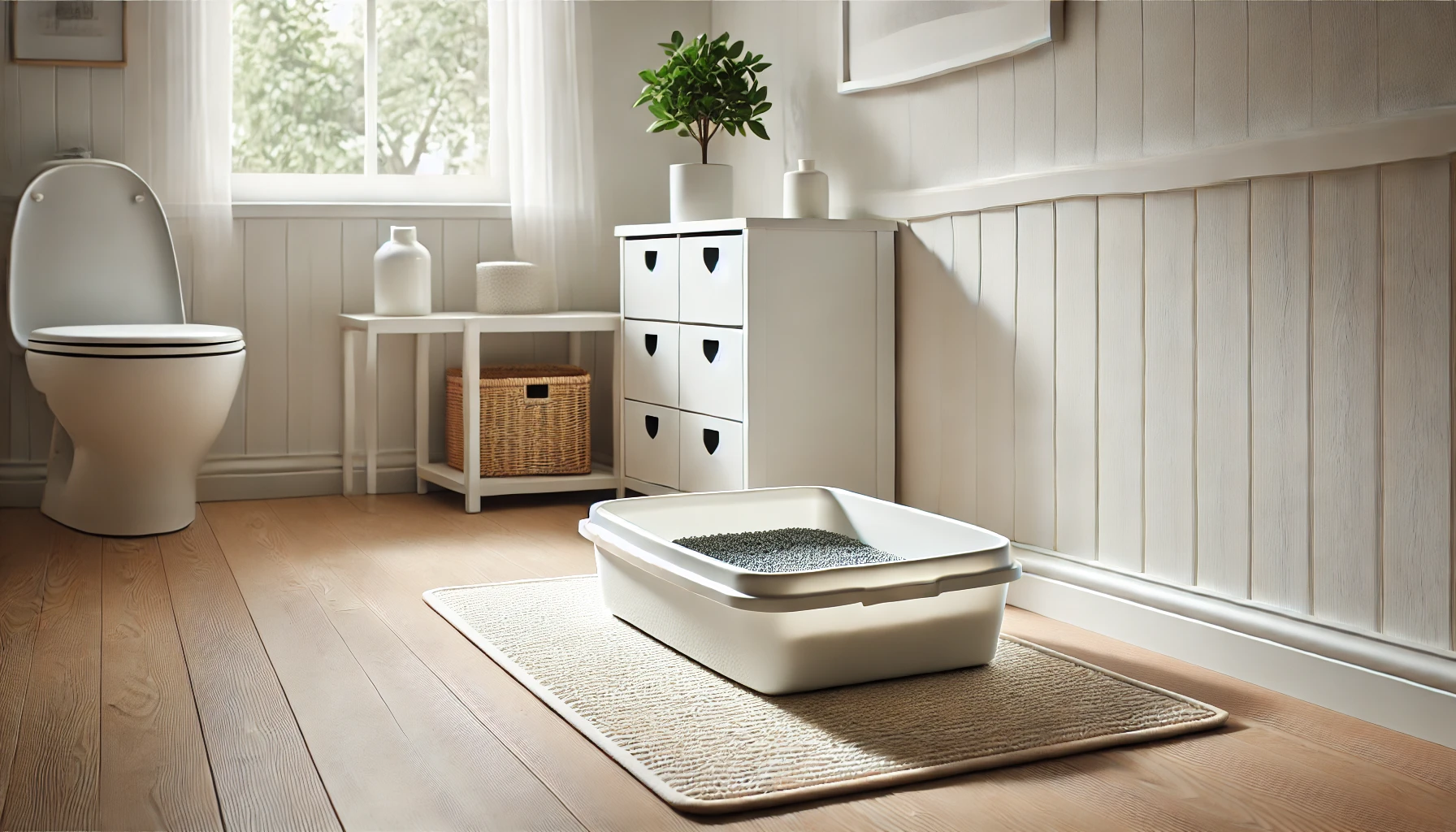
Consistency is Key
Consistency is the most important factor in maintaining a clean and hygienic litter box environment.
With regular cleaning, the right products, and proper litter box placement, you can provide comfort for your cat.
A clean litter box not only improves your cat’s health and behavior but also contributes to a fresher, cleaner home.
By following these suggestions, you will offer your cat a comfortable and hygienic litter box space while creating a cleaner, healthier environment in your home.
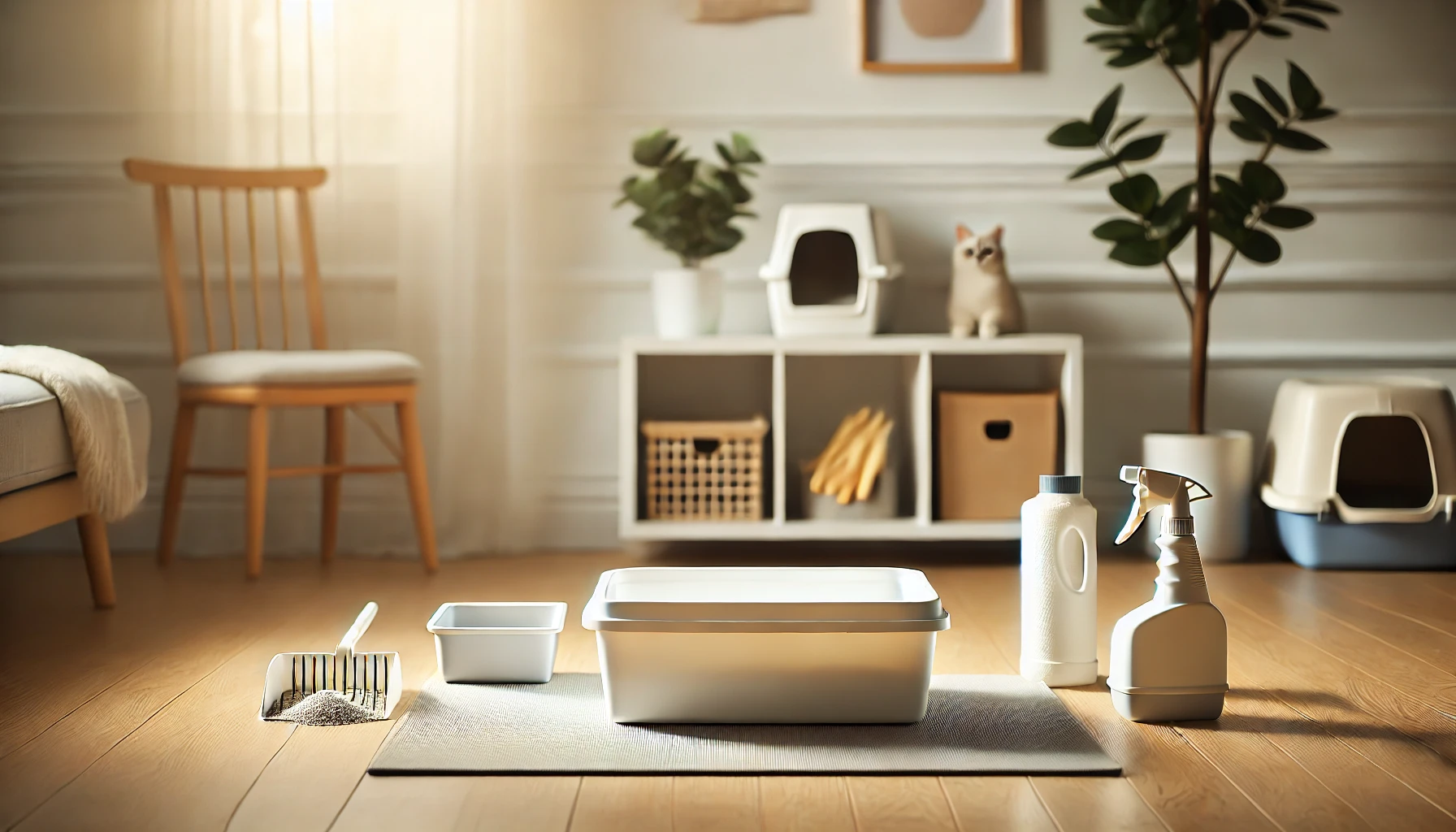
Hygiene of Cats’ Litter Box: Frequently Asked Questions
Below are some of the most common questions about keeping a clean and hygienic litter box for your cat, including answers that will help you manage your litter box effectively.
How often should I clean my cat's litter box?
Clean the litter box once a day, and at least once per week, completely empty and clean it.
If you have more than one cat, you will need to clean it more often.
Can I place my cat's litter box in the bathroom?
Yes, bathrooms can be a good location, provided they offer enough privacy and ventilation.
Just be sure to keep the litter box away from noisy appliances like washers or dryers, as this may stress your cat.
What type of litter is best for odor control?
Clumping litter is generally the most effective at controlling odor, as you can easily scoop out the waste.
For sensitive cats, unscented litters may be worth trying.
Regular scooping ensures optimum effectiveness in controlling odors.
How many litter boxes should I have for two cats?
For two cats, you should have at least three litter boxes.
The rule of thumb is one box per cat, plus one extra to avoid overcrowding and territorial issues.
Why doesn't my cat want to use the litter box?
Your cat may refuse to use the litter box due to cleanliness issues, stress, or territorial behavior.
Keep the box clean, place it in a quiet area, and if you have multiple cats, ensure there are enough litter boxes.
Can self-cleaning litter boxes be shared by several cats?
Yes, self-cleaning litter boxes can work for multiple cats, but make sure the box is large enough and cleaned often.
Some cats may take time to adjust to the self-cleaning mechanisms.
What's the best way to reduce litter tracking?
Placing a litter mat around the box can significantly reduce litter tracking.
These mats catch litter as your cat leaves the box, helping to keep floors cleaner.
Regular sweeping or vacuuming can also help.
Is scented or unscented litter better?
Scented litter can mask odors, but some cats are sensitive to fragrances and may avoid the box.
Unscented litter combined with regular cleaning is usually the safest option, especially for cats with sensitivities.
Where in the house should I put my cat's litter box?
Place the litter box in a quiet area of your home, away from distractions and high-traffic areas.
Ensure good ventilation around the box and avoid placing it in confined spaces, such as closets or corners.

